- Krakow Attractions
- Auschwitz-Birkenau Concentration Camp
- Auschwitz-Birkenau Memorial and Museum
- Krakow to Auschwitz Tour
- Warsaw to Auschwitz Tour
- Wroclaw to Auschwitz Tour
- Movies & Books about Auschwitz
- Plan Your Visit
- Guided Tours

Wieliczka Salt Mine
- Oskar Schindler's Factory Tours
- Energylandia Amusement Park
- Wawel Castle
- Zakopane Thermal Baths
- St Mary's Basilica
- Chocholow Thermal Baths
- Rynek Underground Museum Tickets
- Plaszow Concentration Camp
- Be Happy Museum in Krakow
- Nowa Huta Tours
- Hop-On Hop-Off Tours
- Things to do
- Festivals and Events
Auschwitz tours
Headout is an authorized and trusted partner of the venue, offering curated experiences to enjoy this attraction. This is not the venue's website.

Auschwitz-Birkenau Guided Tour with Fast Track Tickets
- You can cancel these tickets up to 24 hours before the experience begins and get a full refund.
- Take a profound journey through history with an official guide at the Auschwitz-Birkenau Museum, a powerful testament to the human spirit amidst tragedy.
- This ticket has fast-track entry privileges and allows you to pass through the security line and start your tour as quickly as possible.
- Join an authorized tour group, with up to 30 people, led by an expert Auschwitz-Birkenau guide, ensuring an informative and immersive experience.
- Learn about the tragic history and treatment of the Jews and other prisoners of the Holocaust and see the stark ruins of their everyday living conditions.
- Explore the cabins and crematoriums in Birkenau, the watchtowers, railway ramps, and a former gas chamber of this UNESCO World Heritage Site.
- The tour lasts approximately 3.5 hours, with 1.5-2 hours at Auschwitz and 1-1.5 hours at Birkenau, providing ample time to explore both locations thoroughly.
- Fast-track entrance to Auschwitz-Birkenau
- Local host who will meet you close to Auschwitz I
- Guided tour by an official Auschwitz-Birkenau guide
- Parking fees
- Tip: Engage with books, documentaries, and online resources to understand Auschwitz-Birkenau's history and significance for a more meaningful visit.
- This tour is available in English, German, French, Spanish, Italian, Dutch and Polish.
- It is not recommended that children under 14 visit the memorial.
- Note that last-minute tour timing changes may occasionally occur due to the nature of the venue. In rare cases, tours may be rescheduled to the following day, ensuring you still get the full experience.
- The max size of backpacks or handbags brought into the museum shouldn't exceed dimensions: 30x20x10cm (roughly 12x8x4 inches) and 30kg.
- Tour timings and pick-up times may change last minute due to venue requirements. In rare cases, tours might be rescheduled for the next day.

Auschwitz-Birkenau Guided Tour with Transfers from Meeting Point & Optional Lunch
- Visit the Auschwitz-Birkenau Museum, located inside the Auschwitz concentration camp in Oświęcim, and enjoy seamless transfers from the meeting point.
- With an expert guide, understand the consequences of World War II and the Holocaust, walk through the camp, and see the barracks where prisoners resided.
- Unveil chilling details of the grueling lives that inmates here were forced to lead as you come across the various exhibits.
- Your guide will also take you to the camp at Birkenau, to see the past living conditions of the prisoners, and the gas chambers where they were executed en masse.
- Choose the preferred language for your tour guide from 7 available options. Upgrade to include lunch in your ticket.
- 7-8 hour guided tour of Auschwitz-Birkenau
- Expert guide available in 7 languages
- Skip-the-line access
- Lunch (optional)
- AC vehicle transfers from Krakow with meeting point pickup
- Entrance fees
- Tip: Don't miss out on visiting the blocks in the camp that are open to the public as these contain important or interesting historical information panels in Polish and English.
- The live tour guide is available in English, French, Spanish, German, Italian, Dutch and Polish.
- Photography is allowed only in select parts of the Museum. Flash photography is forbidden.
- Note : As per the requirements of Auschwitz-Birkenau Memorial and Museum, all participants are required to provide their full names and contact details as part of the booking.
- Entry may be refused if the name provided on the booking is not identical to the name on the ID provided when entering.

Auschwitz-Birkenau Guided Tour with Hotel Transfers from Krakow Center
- You can cancel these tickets up to 72 hours before the experience begins and get a full refund.
- Immerse yourself in a historical experience with a guided tour of the Auschwitz-Birkenau camp complex.
- Enjoy the convenience of hotel pick-up and drop-off services from central Krakow, with exclusive skip-the-line access to the camp.
- Travel to the Auschwitz-Birkenau complex aboard an AC minibus with an English-speaking driver, while your expert multilingual guide brings history to life.
- Gain a deeper understanding of the Holocaust through a guided tour of the outdoor museum, exhibits, and the camp's harrowing past.
- Choose from 6 language options for your guided tour, catering to your preferences and ensuring an informative experience.
- Entry to Auschwitz-Birkenau
- Expert licensed English, Polish, French, Spanish, Italian, Dutch or German-speaking guide
- Hotel pick-up and drop-off
- Transfers by an AC minivan or minibus
- Audio equipment rental
- Pick-up & drop-off from hotels located far from the center of Krakow
- Tip: Don't miss the documentary on the visitor center. It is a brief introduction with real images of the camp and its prisoners, their way of life, and a summary of the history of the formation of the camp.
- Facilities: WiFi & Cloakroom.
- The tour is available in English, Polish, Italian, French, German, Dutch and Spanish.
- The pace and duration of the tours are determined by the memorial’s visitor service. Hence, the pick-up time/duration of the tour is subject to change.
- Note: As per the requirements of Auschwitz-Birkenau Memorial and Museum, all participants are required to provide their full name and contact details as part of the booking. Entry may be refused if the name provided on the booking is not identical to the name on the ID provided when entering.
- The maximum bag size allowed inside the museum is 30x20x10 cm.
- All sightseeing within the camp can only be done in the company of a licensed guide.
- Pick-up is possible from the hotels located in the center of Krakow. If your hotel location is in an area beyond this or in an area with limited traffic/accessibility, then you will be picked up from the nearest possible pickup place. The exact location and pickup time will be provided to you by the tour operator at least a day before your scheduled tour.
- This tour is not recommended for children under 13 years old. It is up to the parents or guardians to decide whether to let children attend or not.
- Baby carriages and luggage larger than 30 x 20 x 10cm are not permitted inside the museum.

Combo: From Krakow - Auschwitz-Birkenau & Wieliczka Salt Mine Guided Tour
- This experience offers a tour of two concentration camps and a historic mine with a live guide.
- Hotel pickups and drop-offs from your hotel/hostel/accommodation in Krakow add to the convenience of this tour.
- You'll begin at the Nazi Holocaust's largest concentration camp in Auschwitz-Birkenau, a 2-part tour that begins at Auschwitz.
- At the second camp of Birkenau, you'll see the original barracks and locations where prisoners were held. As you walk through the camp, your guide will tell facts and stories about the prisoners.
- Visit Wieliczka Salt Mine, an attraction that speaks to Poland's mineral and religious culture.
- Descend 135 meters below ground level and follow the tourist route past multiple chambers, original sculptures, and authentic miner workplaces.
- Guided tour of Auschwitz-Birkenau & Wieliczka Salt Mine
- Expert English-speaking guide for both sites
- Pick-up from the hotel or from the meeting point
- Private transport in AC vehicle from Krakow
- Entry tickets to both sites
- Pick up from your hotel or meeting point
- Travel to Auschwitz (approx 1h)
- Visit to Auschwitz Museum 1.5hr
- Visit to Birkenau Musuem 1hr
- Lunch break 1hr
- Travel to Wieliczka Salt Mine approx 1hr
- Wieliczka Salt Mine tour 2.5hr
- Travel back to Krakow approx 30min (time may vary depending on the drop-off point)
- Pick-up is possible from the hotels located in the center of Kracow. If your hotel location is in an area beyond this or in an area with limited traffic/accessibility, then you will be picked up from the nearest possible pickup place. The tour operator will provide the exact location and pickup time at least a day before your scheduled tour.
Auschwitz-Birkenau
- Tip: Pay attention to the camp's infrastructure and layout. Observe the barracks, watchtowers, fences, and other structures to get a sense of the scale and conditions of the camp.
- The pace and duration of the tours are determined by the memorial’s visitor service.
- Note: As per the requirements of Auschwitz-Birkenau Memorial and Museum, all participants must provide their full name as part of the booking. Entry may be refused if the name provided on the booking is not identical to the name on the ID provided when entering.
- Tip: Keep an eye out for intricate statues, bas-reliefs, and even entire salt chapels, showcasing the miners' skill and craftsmanship.
- Sightseeing in the salt mine takes place 135 m under the surface where the temperature is between 14 and 16 degrees Celsius. We recommend wearing appropriate clothes.
- The maximum dimensions of a bag: Auschwitz-Birkenau – 30 x 20 x 10 cm, Wieliczka Salt Mine – 35 x 20 x 20 cm.

Auschwitz-Birkenau Guided Tour with Lunch & Hotel Transfers from Krakow Center
- You can cancel these tickets up to 48 hours before the experience begins and get a full refund.
- Visit the Auschwitz-Birkenau camp complex on this guided tour with lunch and hotel pickup from Krakow Center included in your ticket.
- The ticket provides exclusive skip-the-line access that will allow you to enter the museum almost immediately after getting picked up from your hotel or the nearest possible pick-up point.
- Journey to the Auschwitz-Birkenau complex in an AC minibus with an English-speaking driver.
- Follow an expert guide to explore this solemn reminder of one of history’s darkest periods. Pick one of five languages (English, Italian, French, German, or Spanish) for your guided tour of the concentration camp.
- See the exhibits at the outdoor museum and learn more about the camp and its history from your guide.
- Your ticket also includes a lunch box, offering both vegetarian and meat options. You can inform the operator of your choice during the time of booking.
- Guided tour of Auschwitz-Birkenau
- Expert licensed guide (English, French, Spanish, Italian, or German)
- Pick-up from the hotel or from the nearest possible pick-up point
- Service of an experienced driver
- Food: Lunchbox with ham or Cheese Sandwich or Hummus Sandwich Fruits, Chocolate
- Drinks: Water
- Pick-up from the hotels located far from the center of Krakow
- Tip: The weather in Auschwitz is very unpredictable. Winters are really cold (and days short) and the summers are quite hot. Be sure to dress weather appropriately.
- Note: The tour includes pick-up services from the hotels located in the center of Krakow. If your hotel location is in an area beyond this or in an area with limited traffic/accessibility, then you will be picked up from the nearest possible pickup place. The exact location and pickup time will be provided to you by the tour operator at least a day before your scheduled tour.
- Make sure that you provide the tour operator with your hotel room number for the pick-up.

Auschwitz & Birkenau Guided Tour with Transfers & Optional Private Tour
- Dive into a compelling journey through Auschwitz-Birkenau’s somber history, led by a licensed local guide.
- The tour includes seamless roundtrip transfers from Krakow and professional assistance, ensuring an effortless experience.
- Immerse in an engaging narrative through the provided headsets, bringing closer the chilling realities of Auschwitz I and Birkenau.
- Choose to tour with a small group of 15 people or a regular group of 30 people, as per your preferences.
- Appreciate the poignant outdoor exhibitions during well-timed breaks, adding depth to your understanding of WWII atrocities.
- Guided tour of Auschwitz & Birkenau
- Round-trip transfers from and to Krakow by AC vehicle (van or mini-bus)
- Entry to Auschwitz I & Auschwitz II Birkenau
- Licensed, English-speaking local guide
- Private or regular group tour (optional)
- Headsets to hear the guide clearly
- Professional assistance
- Tip: Remember, this is not a photo-op location, but a place for reflection and remembrance.
- Dress code: smart casual, to respect the place.
- Facilities: Infant Seats
- For hotels in Krakow that are located in traffic-restricted areas, your pick-up will be organized from the nearest possible point and you will be informed.
- The hours you book are tentative and may change. The duration of transfers is also approximate. The exact pickup time will be confirmed a day before the tour (in the afternoon at the latest).
- Be prepared to go through a security check (similar to the airport's) in order to enter Auschwitz-Birkenau Museum.
- Bring along a bottle of water and some snacks.
- Eating and smoking, as well as acting in a loud manner are forbidden at the Museum.
- The maximum bag size permitted is 30cm x 20cm x 10cm. You can leave your bags in the car which is locked during your visit.
- It is recommended that visitors should be at least 13 years old. All children must be accompanied by an adult.
- This experience is not wheelchair/stroller accessible.
- The experience is not suitable for pets.
- No public transportation nearby.
- Infants must not sit on laps.
Top things to do in Krakow

Auschwitz-Birkenau | Exploring the history of the holocaust
Auschwitz-Birkenau, often referred to simply as Auschwitz concentration camp, stands as the largest Nazi concentration and death camp, where more than one million people, mostly Jews, were killed during the Holocaust. A visit to this site is a deeply somber, emotional, and thought-provoking experience. Read on to find everything you need to plan a visit to Auschwitz.
Things to know before buying Auschwitz tour ticket
- Opt for a guided tour to fully understand the historical significance of Auschwitz.
- Book your ticket in advance if you want to visit Auschwitz during the peak season (April to October).
- All tickets are timed, so it is important that you reach there at the time you booked, or else you won’t be allowed entry.
- If you're visiting the museum by yourself during peak season, enter the camp before 10 AM or after 3 PM.
- Both camps have limited disabled access, and there are only a few spots inside to sit and rest.
- It is not recommended that children under 14 visit the museum.
- Bring a valid photo ID with your Auschwitz tour tickets to enter. Any official ID with a clear photograph of the visitor will work.
- Since transport in the area is not very easily available, it is advised you book tickets with transfers included.
Which Auschwitz ticket is best for you?

If you're budget-conscious
Go for: Guided tour with Fast-Track tickets Duration: 3 hr. 30 min. Guide: Official Auschwitz-Birkenau guide
- Opt for the fast-track entry ticket as it is one of the cheaper guided tour options. Skip the lines at the ticket office and begin your tour in a hassle-free manner.
- You can also pick one of six languages (English, German, French, Spanish, Italian, and Polish) for your guided tour of the concentration camp.
Recommended ticket:
Guided Tour of Auschwitz-Birkenau with Fast-Track Tickets

If you're looking for hassle-free transfers
Go for: Tickets with round-trip transfers Guide: Expert licensed guide
- If you wish to avoid the hassle of getting to Auschwitz by yourself, opt for tickets, including round-trip transfers from Krakow.
- You will reach Auschwitz comfortably in an air-conditioned vehicle with an English-speaking driver.
Guided Tour of Auschwitz-Birkenau with Lunch & Hotel Pick-Up from Krakow Center
Guided Tour of Auschwitz-Birkenau with Hotel Transfers from Krakow Center

If you're looking for a personalized experience
Go for: Small group tour tickets Duration: 6 hours Guide: Expert licensed guide
- Explore Auschwitz with a small group led by an experienced guide for a personalized and in-depth experience.
- Gain deep insights into the history of the concentration camps and explore the sites peacefully. Enjoy a round-trip journey in an air-conditioned minibus from Krakow.
Small Group Guided Tour of Auschwitz & Birkenau with Transfers from Krakow

If you want to explore beyond Auschwitz
Go for: Combo tickets Duration: 11 hours Guide: Expert English-speaking guide
- If you wish to see more than Auschwitz, opt for the super saver combo ticket that includes a guided tour of concentration camps and Wieliczka Salt Mine.
- This experience also includes free transfers in an AC vehicle and lunch with vegetarian and non-vegetarian options.
Combo: Auschwitz-Birkenau & Wieliczka Salt Mine Guided Tour from Krakow with Optional Lunch
Cancelation Policy
Most Auschwitz tour tickets can be canceled 24-48 hours before the experience begins. However, some tickets cannot be canceled or rescheduled. Please check your ticket for details at the time of booking.
Why visit Auschwitz?

- Cultural significance: As a UNESCO World Heritage site, Auschwitz-Birkenau holds immense cultural and historical significance. It's a must-visit for those interested in the past but also for those who wish to build a better future.
- Educational value: Auschwitz-Birkenau offers a unique opportunity to learn about the Holocaust and the atrocities committed during World War II.
- Paying respect: By visiting, you pay your respects to the millions who suffered and perished here. It's a way to honor their memory and ensure that their stories are never forgotten.
- It's a place of reflection : Walking through Auschwitz-Birkenau allows for personal reflection. It’s an opportunity to contemplate the importance of tolerance, compassion, and the prevention of such horrors in the future.
Auschwitz tour highlights
Auschwitz-Birkenau is made up of three parts: Auschwitz I, Auschwitz II-Birkenau, and Auschwitz III-Monowitz. The first two camps are about 3 kilometers apart, and any Auschwitz tour will take you to both of them. The third camp was a labor camp and there’s nothing left of it currently, save a memorial on the road.

Auschwitz-Birkenau Museum
This holocaust museum showcases the works made secretly by prisoners that showcase their lives in the concentration camps. You will also find works made for the SS for the expansion of the Auschwitz camps and post-war collections. Visitors here will get to explore two main camps: Auschwitz I and Auschwitz II-Birkenau.

Auschwitz I
Auschwitz I, which opened in 1940, was the first concentration camp and headquarters of the SS. You can see the barracks, prison cells, and the black and white photographs of the camp from when it was in operation. You will also learn about the horrifying death statistics and encounter belongings of the prisoners here.

Auschwitz II-Birkenau
Auschwitz II – Birkenau was opened in 1941 to keep up with the large numbers of political prisoners and Jews who were being deported to Auschwitz. See the railway tracks and original cattle cars that were used to transport the deportees, the ruins of the crematorium and barracks, and get a glimpse into the living conditions of prisoners.
Plan your visit to Auschwitz
Auschwitz-Birkenau entrance hours:
- December: 7:30 AM - 2 PM
- January & November: 7:30 AM - 3 PM
- February: 7:30 AM - 4 PM
- March, October: 7:30 AM - 5 PM
- April, May & September: 7:30 AM - 6 PM
- June, July & August: 7:30 AM - 7 PM
Closed on: January 1, December 25, and Easter Sunday. Duration : 4-5 hours Best time to visit : Plan a visit in the morning during the weekday in the months of April to May to avoid the peak crowds.

Address: Ofiar Faszyzmu 12, 32-600 Brzezinka, Poland Find on Map
Getting there:
- By train: Take a direct train from Krakow Glowny station to Oswiecim station, located 2 km from the Auschwitz concentration camp. The journey will take around 1.5 - 2.5 hours.
- By Bus: From Krakow MDA Bus Station, there are four bus carriers that run between Krakow and Auschwitz and will drop you off at the Auschwitz I camp.
- By Car: You can also arrive by car and park your vehicle in the paid car parking spaces available near the concentration camps.
- Guided Tour: You can also take a guided tour from Krakow to Auschwitz which will take around 7-11 hours and can be completed as a day trip.

Auschwitz-Birkenau has two primary entrances:
- Auschwitz I Main Entrance: This iconic wrought-iron gate, adorned with the chilling words "Arbeit Macht Frei" (Work Sets You Free), marks the entrance to the Auschwitz I camp. It's a poignant reminder of the camp's dark past.
- Auschwitz II Birkenau Hell's Gate: The second entrance leads to the vast expanse of Auschwitz II Birkenau, known for its vastness and solemnity, with the iconic railway tracks leading to the camp.

- Toilets : There are toilets available at both the camps but you need to pay a small fee to use them.
- Refreshments : Auschwitz I camp has a restaurant and a fast-food counter to get food and drinks but there is no food available at Auschwitz II camp.
- Free shuttle bus service: A free shuttle bus is available to travel between the two camps — Auschwitz I and Birkenau.
- Storage room: There is a luggage storage facility available near the main entrance.
- Book shops: You can buy books from the book shops that are open in both the camps. You can also buy these books from the online book shop of Auschwitz.
- Wheelchairs: Wheelchairs are available free of charge at the Visitor Service Centre for differently-abled visitors.

- There is a lot of walking involved. Wear comfortable shoes and carry plenty of drinking water. Both camps have limited disabled access, and there are only a few spots inside to sit and rest.
- Ensure your backpack or handbag does not exceed dimensions: 30x20x10 cm. There are lockers available for a small fee, but they tend to get full during peak season.
- You need to pay 2 PLN to use the toilets inside the memorial.
- If you are not familiar with the history of Auschwitz or any other concentration camp, we recommend that you read about the holocaust before your trip. Here are some books to get started on, and if you like movies more than books, here are some suggestions to help explain this better.
- Visitors can photograph the insides of the Auschwitz Memorial but avoid flat photography and pay attention to the No Photography signs inside.
- It is recommended to not bring children aged 14 and under to the museum as the experience can be too traumatic for them.

Auschwitz I has a cafeteria that provides meals and water, but if you want to explore other options, here’s what we suggest:
- Bistro Bilard: If you are looking to eat some pizza and chase it down with some cold beer, look no further than this no-frills joint across the street from the camp.
- Kebab Pizza Burger Allis: A 12-minute walk away, the restaurant offers a wide selection of Italian, American and Turkish dishes. Their burgers come highly recommended.
- A La Carte: For those looking to enjoy an authentic Polish meal, head on to this restaurant, only 1 km away from the Auschwitz Memorial and Museum.
.jpg?auto=format&w=814.9333333333333&h=458.4&q=90&ar=16%3A9&crop=faces)
Here's a list of hotels near Auschwitz:
- Budget hotels : B&M Guesthouse , Hotel Dąbrowski , Villa Centro apartamenty ze śniadaniami
- Mid-range hotels : Hotel Olecki , Hampton by Hilton Oswiecim , Novotel Katowice Centrum
- Luxury hotels: Hotel Imperiale, Qubus Hotel Bielsko-Biała
Beyond Auschwitz

Admire the unique statues sculpted in salt, underground chapels, and works of art at Wieliczka Salt Mine, a UNESCO Heritage Site. Explore the miner workplaces and underground salt labyrinth, and marvel at the underground lakes, the numerous chambers carved in salt, and more.

Oskar Schindler’s Factory
Visit Krakow's famed Oskar Schindler’s Factory Museum, where WWII history unfolds. Explore Schindler's heroic acts, saving 1,200 Jews. Immerse in recreated rooms, personal artifacts, and photos. Discover wartime Krakow's story, from prewar life to German occupation and Jewish resistance, through exhibits of photos, artifacts, and documents.
Frequently asked questions about Auschwitz tickets
The Auschwitz tour price starts from zł96.19. This includes fast-track entrance to Auschwitz-Birkenau and a guided tour by an official Auschwitz-Birkenau guide.
The best way to buy tickets to Auschwitz tours is by booking them online. Online booking is easy and convenient as it allows you to avail of exclusive discounts on Auschwitz tickets and reserve your slots well in advance.
Yes, you can buy tickets to Auschwitz tours online. Scroll up to choose from all the Auschwitz ticket and tour options.
- Booking Auschwitz tours online offers many advantages like: -Skip the lines: Auschwitz is a popular place, especially in peak tourist season, so the lines can get long. Booking your tickets online helps avoid these long entry lines and gives you more time to explore. -Guaranteed entry: When you book tickets online in advance, you get guaranteed entry upon arrival. -Choose from a variety of experiences: Make your Auschwitz visit your own by picking the type of visit you like. You can have a guide show you around, or book combo tours to see other attractions. -Discounts and Deals: When you book online, you can get some great discounts and special deals that you won't find at the ticket booth.
Yes, you can get skip-the-line tickets for the Auschwitz tour and get priority access inside.
Yes, all Auschwitz tour tickets allow entry into the Auschwitz Birkenau Museum.
Yes. Children aged less than 12 years and students with a valid ID can enjoy discounts on the Auschwitz tickets.
Cancellation policy varies based on the type of ticket you select. Some ticket options provide a complete refund if you cancel up to 48-72 hours before your scheduled visit, while others may not allow cancellations. Pease review the specific terms and conditions before finalizing your reservation.
You can buy the tickets to Auschwitz tours on the day but the tickets are subject to availability and you would have to stand in the long queues during peak times. Furthermore, online ticket holders are prioritized at the venue over on-the-spot ticket buyers. Additionally, if you opt to purchase the Auschwitz tickets offline, you would be missing out on discounts and offers as well.
Yes, you will need to bring a valid photo ID along with the Auschwitz tickets to enter. Any official ID with a clear photograph of the visitor will work.
- December: 8:00 AM - 2:00 PM
- January & November: 8:00 AM - 3:00 PM
- February: 8:00 AM - 4:00 PM
- March, October: 8:00 AM - 5:00 PM
- April, May & September: 8:00 AM - 6:00 PM
- June, July & August: 8:00 AM - 7:00 PM
An Auschwitz tour can last anywhere between 3 to 11 hours, depending on the experience that you have selected.

About Auschwitz

Plan Your Auschwitz Vist

The Auschwitz Museum
Select the type of the visit
IMPORTANT NOTICE: The only official website with entry cards to visit the Auschwitz Museum is visit.auschwitz.org. The Museum is not responsible for bookings made on any other sites
In order to enter the Auschwitz Memorial all visitors, also those coming in organized groups, must have their personalized entry pass and ID with them. All guided tours start at former camp Auschwitz I.
Copyright © 2014 Państwowe Muzeum Auschwitz-Birkenau. All rights reserved


MEMORIAL AND MUSEUM AUSCHWITZ-BIRKENAU FORMER GERMAN NAZI CONCENTRATION AND EXTERMINATION CAMP
The post-camp relics are protected by the Museum created in 1947. The Memorial today is i.a. the Archive and Collections as well as research, conservation and publishing center.
- Auschwitz Council
- Preservation
- Historical collection
- Museum Reports
- Projects EU
- Museum Structure
- History of the Memorial
- Photo gallery
- Auschwitz prisoners
KL Auschwitz was the largest of the German Nazi concentration camps and extermination centers. Over 1.1 million men, women and children lost their lives here.
- Home Page - History
- Before the extermination
- Auschwitz I
- Auschwitz II
- Auschwitz III
- Auschwitz sub-camps
- Auschwitz and Shoah
- Categories of prisoners
- Fate of children
- Prisoner classification
- Life in the camp
- Punishments and executions
- Camp hospitals
- Medical experiments
- Informing the world
- The number of victims
- The SS garrison
- Holocaust denial
- Auschwitz Calendar
The authentic Memorial consists of two parts of the former camp: Auschwitz and Birkenau. A visit with an educator allows better understanding of this unique place.
- Home Page - Visiting
- Preparation and summary of a visit
- Reservation
- Tours options
- Online guided tours
- Rules for Visiting
- Opening hours
- Temporarily closed for visitors
- Getting to the Museum
- Permanent Exhibition
- National Exhibitions
- On-line Exhibitions
- Virtual tour
- Plan your visit
- Information plaques
There is no way to understand postwar Europe and the world without an in-depth confrontation between our idea of mankind and the remains of Auschwitz.
- Home Page - Education
- Study visits
- Educational projects
- Conferences
- Thematic sessions
- Exhibitions
- Visiting the Memorial
- Publications
- Volunteer Bureau
- Resources for teachers
- ICEAH – General Information
- Light of Remembrance
- Library - Online Catalogue

"Auschwitz. Not long ago. Not far away" exhibition in Boston
The travelling exhibition created by the Auschwitz Museum and the Spanish company Musealia was opened at The Castle at Park Plaza in Boston on 14 March. It will be on display there until 2 September.

Evil does not beget good, but good cannot be conquered. 79th anniversary of the liberation of Auschwitz.
On 27 January 2024, twenty Auschwitz and Holocaust Survivors took part in the commemoration of the 79th anniversary of the liberation of the German Nazi concentration and extermination camp. The event was held under the honorary patronage of the President of the Republic of Poland, Andrzej Duda.

"To reach people in the most remote corners of the world". The launch of the online tours of the Auschwitz Memorial.
"Auschwitz in Front of Your Eyes" is an application through which millions of people from around the world will gain access to education conducted directly from the authentic Memorial Site. It allows an online guided tour of the former German Nazi camp. Reservations: visit.auschwitz.org .

New online bookstore of the Museum
The new online bookstore of the Museum is now available at books.auschwitz.org . In addition to printed publications in many languages, ebooks are also available on the website.

New research laboratory of the Museum conservators
A new research laboratory was opened at the Auschwitz Museum. It will allow specialized research on objects from the German Nazi concentration and extermination camp Auschwitz.
The new laboratory is equipped to carry out physicochemical research and molecular biology analysis, including microbiology and genetics.

Today, once again, comes the time for essential human choices. 78th anniversary of liberation of Auschwitz.
On January 27, a group of 18 Auschwitz and Holocaust Survivors met at the former Auschwitz camp to commemorate the 78th anniversary of the liberation of this German Nazi concentration and extermination camp. The main theme of the anniversary was the process of planning, creating and expanding the system of dehumanisation and genocide at Auschwitz, which was particularly strongly defined by the words of survivor Marian Turski 'Auschwitz did not fall from the sky'.
ONLINE LIVE GUIDED TOURS OF THE AUSCHWITZ MEMORIAL FOR GROUPS AND INDIVIDUAL VISITORS

"Preserve Authenticity" - online educational session on preservation - 28 May 2024.

31st March of the Living

Memoria Magazine no. 79

Call for participants of the German-Polish seminar “How to Deal with Difficult Past?”

Prof. Marc van Berkel appointed Honorary Consul of the Auschwitz Memorial in the Netherlands

Camp chess pieces found in one of the historic buildings

Volunteers from the Brynek Forestry Technical School help protect the Museum's green spaces

Memoria Magazine no. 77

"A piece of the world surrounded by barbed wire..." The fate of Polish citizens in KL Auschwitz - a new temporary exhibition

The fate of the Sinti and Roma in KL Auschwitz - free study visits for young people
- Nasz profil na facebook
- via @auschwitzmuseum"> Udostępnij na Twitter
- Nasz profil na Pinterest
- Nasz profil na YouTube
Auschwitz Memorial / Muzeum Auschwitz
Wyświetl ten post na Instagramie. "Come here you free citizen of the world, whose life is safeguarded by human morality and whose existence is guaranteed through law. I want to tell you how modern criminals and common bandits have betrayed the morality of life and nullified the postulates of existence." - Zalman Gradowski, member of Sonderkommando at Auschwitz, murdered during the uprising on October 7, 1944. Auschwitz I. Block 27. Shoah exhibition. --- Photo by @tofudonbe --- #Auschwitz #Birkenau #AuschwitzMemorial #Nazi #Germany #concentrationcamp #extermination #genocide #history #Holocaust #Shoah #Jews #Poles #Roma #people #life #death #humanity #humiliation #dehumanization #remembrance #commemoration #memory #museum #Poland #igerspoland #UNESCO #worldheritage #worldHeritagelist @unesco #photography Post udostępniony przez Auschwitz Memorial and Museum (@auschwitzmemorial) Paź 27, 2019 o 11:17 PDT
Images from www.auschwitz.org may be used only in publications relating to the history of the German Nazi concentration and extermination camp Auschwitz-Birkenau or the activities of the Auschwitz Memorial. Their use must not tarnish the good reputation of the victims of KL Auschwitz. Any interference in the integrity of the images – including cropping or graphic processing – is prohibited. The use of the images for commercial purposes requires the Museum’s approval and information about the publication. Publishers undertake to indicate the authors and origin of the images: www.auschwitz.org, as well as to inform the Museum of the use of the images ([email protected]).

Home » Travel Guides » Poland » 12 Best Auschwitz Tours
12 Best Auschwitz Tours
In April of 1940, Auschwitz was established as an extermination camp for Jews shipped in from all over Europe.
Arguably one of the most historically significant and poignant attractions in the world, for most visitors, it ends up being one of the most shocking and memorable experiences of their lives.
A variety of tours are offered, and most originate from the nearby city of Krakow.
The facility includes hundreds of buildings, watchtowers, and gas chambers, and fascinating first-hand accounts of soldiers and prisoners who stayed at the camp during World War II.
Below are 12 of the best tours of Auschwitz.
1. Auschwitz and Birkenau Tour with Licensed Guide

Auschwitz and Birkenau were ground zero for many atrocities committed during the Second World War, and previous visitors agree that they’re both heartbreaking and memorable places.
This full-day tour lasts between six and seven hours and includes the services of a licensed guide.
The tour includes stops at prisoner barracks, the gas chambers, crematoriums, and soldiers’ quarters, all of which contain informative signs so you’ll learn about the things you’re seeing.
Tours end at the memorial, where it’s common for visitors to relax and take a few moments to contemplate the magnitude of events that took place more than 80 years ago.
2. Guided Auschwitz and Wieliczka Salt Mine Tour from Krakow

Though pretty much everyone is relatively familiar with the basic history of Auschwitz, the salt mines at Wieliczka aren’t so well-known.
This 11-hour guided tour from Krakow is a bit on the long side, but it offers guests a look into the area’s macabre history that’s more in-depth than typically found on shorter tours.
You’ll see all the main attractions in the camp, as well as the underground labyrinth of salt mines, where forced laborers toiled in abominable conditions.
The tour includes both guided portions as well as free time for personal exploration and quiet contemplation.
Transportation, park entry fees, and headphones are included in the tour.
View Prices & Reviews
3. Auschwitz-Birkenau Museum & Camp Guided Tour

For some visitors, spending a full-day in Auschwitz and Birkenau is too much.
The site is brimming with horrors that can be overwhelming to many; for those, it’s wise to consider a brief half-day tour to start.
If, on the other hand, you’re ready for full immersion, this eight-hour tour might be a great fit.
You’ll get to see the camp’s main attractions, as well as learn about its status as the Third Reich’s largest extermination center that wasn’t liberated until January of 1945.
The tour includes round-trip transportation from Krakow, entrance fees, the services of a local professional guide, and the use of headsets while in the museum.
4. Self-Guided Tour of Auschwitz-Birkenau from Krakow

For quiet, reflective types, spending a full-day with a talkative guide may not be the best way to spend time at Auschwitz and Birkenau.
Self-guided tours are popular options for many travelers; though you may miss some unique insights, the facility is packed with exhibits, historical plaques, and first-hand accounts.
Due to their location, Auschwitz and Birkenau were primarily filled with Poles, but nearly one million Jews from all over the continent would eventually be sent there for work and extermination.
This seven-hour tour includes transportation to and from Krakow, an English-speaking driver, and all entrance fees.
Food and drinks are available, but they aren’t included in the cost of the tour.
5. Auschwitz-Birkenau Tour with 4 Guests

During much of World War II, Poland was occupied by Nazi troops; the city of Oświęcim was where they built the facilities to hasten their plan for genocide.
This small-group tour is limited to just four guests, so it’s perfect for those who’d rather get a more intimate experience than they would in larger groups.
Guests will get up-close-and-personal with the camp’s most heinous and historic attractions. Due to its small size, this tour is much more customizable than most others.
It’s open to those of most ages and levels of physical ability, but it’s not accessible for those who use a wheelchair.
6. Auschwitz-Birkenau Day Trip from Katowice

For those who want all the details of their trip to Auschwitz-Birkenau handled by professionals, this full-day tour would be a wise choice.
Transportation to and from Katowice is provided in a car, minivan, or bus, depending on the number of guests.
Guests will walk past the crowds with their skip-the-line tickets. Once on-site, they will have 3 ½ hours to explore with their English speaking guide.
Expect to be shocked, educated, and emotionally exhausted as you walk amongst the recreated ruins of the worst Nazi death camps of World War II before heading back to your hotel in Katowice.
7. One-Way Bus Direct between Auschwitz-Birkenau and Krakow

Round-trip transportation is a big selling point for many international travelers visiting Auschwitz and Birkenau, but for those who prefer to fly by the seat of their pants, one-way transfers are often the way to go.
The trip from Krakow to the camps takes about 1 ½ hours. Once on-location, guests will have the option of exploring the facilities on their own or hooking up with a guided group.
You’ll learn about the harsh and deadly lives the prisoners endured and see the camp’s facilities as well as the museum and memorial to the dead.
There are multiple departures daily, and return trips are available too.
8. Auschwitz Tour from Wroclaw

Wroclaw is a bit farther from the camps than Krakow, but it’s still a relatively easy day trip for those who’ve got an entire day to dedicate to one of the world’s most significant attractions.
Plan on being worn-out physically and emotionally after touring the camp and learning about the unspeakable atrocities committed.
For those traveling with kids, infant seats are available, but due to space restrictions, it’s not open to those using a wheelchair.
This tour is limited to eight guests, making it a good fit for families. From beginning to end, the day usually lasts between nine and ten hours.
9. Auschwitz-Birkenau from Krakow with Private Car

For history buffs and those whose lives were personally changed by the atrocities committed during the Second World War, Auschwitz and Birkenau are definitely must-visit attractions.
They’re the perfect places to get caught up on historical events, pay your respects to the fallen, and get shocking insight into the dark side of humanity.
This private car tour begins and ends in Krakow and includes entrance fees, round-trip transportation, and the services of a guide if that option is chosen at booking.
It’s typically a six or seven-hour day, which means guests are back in Krakow by late afternoon.
10. Auschwitz-Birkenau Memorial Tour from Krakow

Tours with options are big hits these days, especially with savvy travelers looking to stretch their travel dollars and spend their time seeing the things that interest them.
If you fall into this category, this memorial tour from Krakow is worth a look.
Guests will have the option of exploring the two sites on their own or signing up for a guide to show them around.
Whichever option is chosen, you’ll have ample time to see everything for which the camps are known.
Transportation via air-conditioned vehicle is included, but food, drinks, and tips are the responsibility of the participants.
11. Private Tour of Auschwitz from Prague

The distance from Prague to Auschwitz is nearly 280 miles, but there’s a doable day-trip tour option for those with boundless energy.
It’s about five hours of driving each way, but once at the camp, guests will have about four hours to explore on their own or hook-up with a professional guide if they choose that option.
Most guests agree that four hours is sufficient to see the camp’s sights, and hotel pickup and drop-off are included.
Though food and drinks aren’t included, there will be the opportunity to stop en route at restaurants and cafes in both Poland and the Czech Republic.
12. Auschwitz-Birkenau Guided Minivan Tour from Krakow

Auschwitz’s most revolting features include gas chambers, gallows, and barracks, where overworked inmates spent long nights fighting against hunger, frigid weather, and physical exhaustion.
Needless to say, the site tends to bring a host of emotions to the forefront. During the war years, it was where the lives of more than a million poor souls were taken.
These days, much of the facility has been constructed to near-original condition, and this guided minivan tour from Krakow allows guests a few hours to explore the grounds.
The tour also includes a side excursion to nearby Birkenau, where guests will have about 1 ½ hours before loading up and heading back to Krakow.
Round-trip transportation, entrance fees, and headsets are all included.
12 Best Auschwitz Tours:
- Auschwitz and Birkenau Tour with Licensed Guide
- Guided Auschwitz and Wieliczka Salt Mine Tour from Krakow
- Auschwitz-Birkenau Museum & Camp Guided Tour
- Self-Guided Tour of Auschwitz-Birkenau from Krakow
- Auschwitz-Birkenau Tour with 4 Guests
- Auschwitz-Birkenau Day Trip from Katowice
- One-Way Bus Direct between Auschwitz-Birkenau and Krakow
- Auschwitz Tour from Wroclaw
- Auschwitz-Birkenau from Krakow with Private Car
- Auschwitz-Birkenau Memorial Tour from Krakow
- Private Tour of Auschwitz from Prague
- Auschwitz-Birkenau Guided Minivan Tour from Krakow
- Help Desk & Booking
- [email protected]
- +48 570 599 599
- +48 570 792 792
- Mon to Sun 7:00 - 22:00 CET

- Auschwitz Tours from Krakow
- Krakow Salt Mine Tours
- Auschwitz Birkenau & Salt Mine Day tour
- Auschwitz & Schindlers Factory Day tour
- Salt Mine & Schindlers Factory Day tour
- Krakow Walking Tour
- Krakow sightseeing by electric golf cart
- Vistula River Cruise
- Zakopane Tours
- Schindler’s Factory Tour
- Krakow airport transfer
- Katowice Airport transfers
- Krakow airport to zakopane
- All Transfers
- All transfers
- Business Services
- Tailor Made
- Early booking deals
- Client’s feedback
AUSCHWITZ TOURS FROM KRAKOW
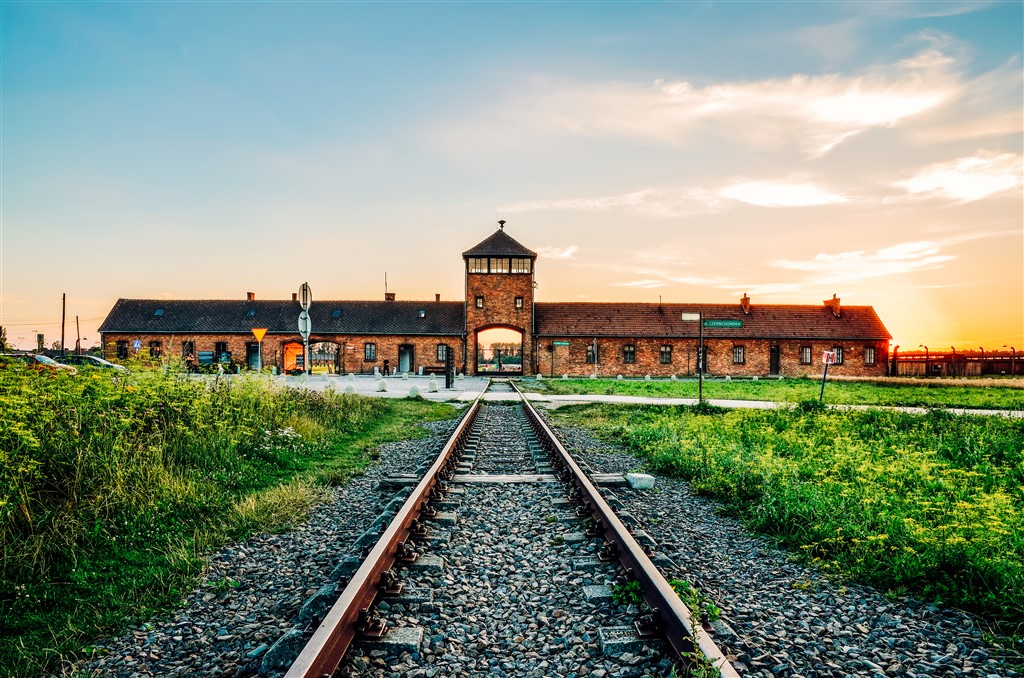
Select tour date:
Choose your type of tour:.
Choose your option:
Visit auschwitz with krakowdirect.
Auschwitz tours to Auschwitz former concentration camp known all over the world as a symbol of the Holocaust.
During World War II, Auschwitz-Birkenau was the largest concentration camp of the Nazis . It was established in the suburbs of the city of Oswiecim (Auschwitz in German), 60 kilometres west of Krakow. It took the lives of about 1.1 million people , mostly Jewish but also Poles, Romani, and Russian. The liberation of Auschwitz-Birkenau concentration camp took place in January 1945. However, before that Nazi authorities tried to destroy as much evidence of massive murders as possible. After the war, the Polish government decided to restore Auschwitz-Birkenau and turn it into a museum . It preserves the memory of Auschwitz-Birkenau and honours the victims of Nazism. Now it is part of the UNESCO list of World Heritage Sites , and more than 2 million tourists visit Auschwitz each year.
Private car Auschwitz tours with a shared or private guide
Our Private Auschwitz-Birkenau Tour from Krakow takes approximately 7 hours . We offer door-to-door pickup and drop-off , a private, modern car and a friendly, English-speaking tour leader/driver . We will set up the pickup time based on the hour you have requested and fit it into the entry time options to the Museum to make It as comfortable for you as possible. The journey to Auschwitz takes about 1 hour and 10 minutes each way. In the Museum, you can either join a regular/shared guided tour or book a private guided tour . Private guided tours need to be booked at least 8 days in advance. The sightseeing takes about 3.5 hours —approximately 2 hours in Auschwitz I and 1,5 hours in Auschwitz II Birkenau. You may also consider visiting Auschwitz Birkenau and Salt Mine or Auschwitz Birkenau and Schindler’s Factory in one day to save your precious holiday time. After the tour, we will drop you off at your hotel in Krakow. The tour can be extended upon request for an additional charge.
Our special bonus for this Auschwitz Tour
If you decide to book our Auschwitz Tour, we have got something extra for you. Each day at 19:00, we organise an Evening Walking Tour , which you can join completely for free. It starts at the Jan Matejko Square under the “Grunwald Monument”. You will meet our professional city guide there, who will show you the best of Krakow Old Town. You will walk down the Royal Route and finish under Wawel Castle near the Dragon Monument. It takes about 1 hour. You can participate in this tour on any day of your visit in Krakow.
Shared tours to Auschwitz
Our Shared Auschwitz-Birkenau Tour from Krakow takes approximately 7 hours. We offer door-to-door pickup from any central Kraków accommodation and a meeting point option is also available. We provide a Modern Mercedes Benz vehicle and a friendly English-speaking tour leader . We will schedule the pickup time according to the requested hour, as we aim to optimise the minibus route through the city to ensure maximum comfort for you. The journey takes about 1 hour and 10 minutes each way. The Auschwitz-Birkenau guided tour with a professional English-speaking guide or other language of your choice takes about 3.5 hours —approximately 2 hours in Auschwitz I and 1,5 hours in Auschwitz II Birkenau. You may also consider visiting Auschwitz Birkenau and Salt Mine or Auschwitz Birkenau and Schindler’s Factory in one day to get the most out of your city break in Krakow. After the tour, we will drop you off in Krakow city centre.
Early booking deals - 20% off
€ 53 book now
€ 103 book now
You could also consider
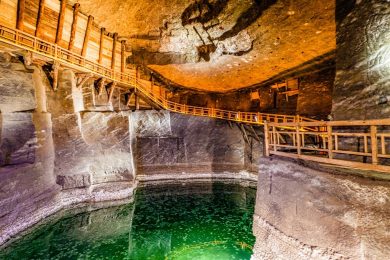
{{contact.responseMsg}}
{{contact.errors}}
Your message has been sent to us. Thank you. We will get back to You in up to 120 minutes within our working hours (Monday to Sunday from 7:00 to 22:00 CET)
Auschwitz-Birkenau Memorial and Museum Guided Tour
The former concentration camp in Auschwitz Memorial and Museum is one of the most popular attractions for day trips from Krakow. Tourists from all over the world visit Auschwitz in Poland to pay tribute to everyone who died there. The Museum, located in Oświęcim, preserves the memory of every person sent to Auschwitz-Birkenau and reminds us about the dreadful times of World War II and the Holocaust. It represents extremely important history and should be visited by every adult. Even though the tours to Auschwitz can be emotional and difficult, it is a must during your stay in Krakow.
Auschwitz-Birkenau Museum in Poland
Auschwitz-Birkenau State Museum is a museum on the site of former concentration and extermination camp in Oświęcim. It consists of two parts – Auschwitz I and Auschwitz II-Birkenau . Both were developed and ran by Nazi during its occupation of Poland during World War II. The museum was created in April 1946 by Tadeusz Wąsowicz and other former Auschwitz-Birkenau prisoners, acting under the direction of Poland’s Ministry of Culture and Art.
The first exhibition in the barracks opened in 1947 . It presented the history of extermination and the conditions in which the prisoners lived. A new exhibition was opened in 1955. With some changes, it is still in use today. After 1960, some of the camp blocks contained the so-called “ national exhibitions ,” created at the initiative of former prisoners of the largest holocaust concentration camp from various countries who are associated in the International Auschwitz Committee. In 1979, the Museum built on the grounds of former concentration camp of Auschwitz became a World Heritage Site. Today, it is visited by around 2 million people from all over the world every year.
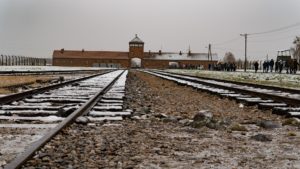
Learn About The History of Auschwitz Concentration Camp
Before the tour begins, it’s very important to read about the Museum and learn more about the history of Nazi concentration and extermination camp. Camp Auschwitz-Birkenau was a complex of over 40 concentration and extermination camps operated by Nazi Germany in occupied Poland during World War II. At first, it was supposed to be a prison for political criminals from Poland, but soon it turned out that people sent to Auschwitz were mostly civilians of Jewish, Polish and Roma ethnicities.
Construction of the Camp
Construction of the camp began in 1940 , when Auschwitz – the main camp and the administrative quarter of the complex – was built. The first mass transport – of 728 Polish male political prisoners, including Catholic priests and Jews – arrived on 14 June 1940 from Tarnów, Poland. Upon arriving, the prisoners were being registered, given a serial number, tattooed, shaved, disinfected, and given a striped prison uniform. Then they were subjected to excruciating labor and life in horrible conditions .
KL Auschwitz Expansion
In 1941 , it was decided that the KL Auschwitz I needs to be expanded. The same year prisoners of Auschwitz began construction work of Birkenau – additional camp in the town of Brzezinka , about 3 km from Oswiecim. Birkenau consisted consisted mostly of wooden barracks , which were very dangerous to live in, as they didn’t provide much protection from weather conditions (such as intense cold or rain).
That’s why a lot of the prisoners living in Birkenau died out of hypothermia , starvation or exhaustion . It is said that Birkenau held the biggest part of the mass murder apparatus and the majority of prisoners were murdered there.
Life in Auschwitz
Due to many reports of former inmates, we now have a rather broad knowledge about how the life in Auschwitz-Birkenau looked like. We know that the prisoners were divided into categories , based on their nationality , ethnicity , and even sexual orientation or health issues . Each day they woke up at very early hours, used and washed latrines, had a very calories-deficient breakfast and gathered to be counted. No matter the weather, they had to wait for the SS to arrive for the count; how long they stood there depended on the officers’ mood, and whether there had been escapes or other events attracting punishment.
They were often counted and re-counted, after which they walked to their place of work with a cheerful melody of Women’s Orchestra of Auschwitz in the background. They were supervised by the kapos and an SS escort. Much of the work took place outdoors at construction sites, gravel pits, and lumber yards. No rest periods were allowed. In the evening the prisoners were counted again – if someone was missing, the others had to remain on site until they were found.
The prisoners were tortured, ridiculed, and humiliated for no reason whatsoever. Even the most benign of misconduct could earn them beating, punishment in Block 11 or even death. They were also living in constant fear of crematoria , which consisted of a dressing room, gas chamber, and a furnace room . The first gassings at Auschwitz took place in early September 1941, when around 850 inmates – Soviet prisoners of war and sick Polish inmates—were killed with Zyklon B in the basement of Auschwitz I. In the years to follow, the use of crematoria became even more prevalent, with new gas chambers being constructed and many prisoners sent there without ever stepping foot inside the barracks or other living complexes of Auschwitz-Birkenau camp.
The Aftermath of Auschwitz-Birkenau Camp
Today, Auschwitz-Birkenau is known as the biggest Nazi German concentration camp . It’s one of the best-recognized symbols of Holocaust and World War II genocide. Its prisoners were living in terrible sanitary conditions and forced to endure unbelievably hard labor. They were often beaten, humiliated, and treated with no respect for human rights whatsoever. Many died out of exhaustion, starvation, or by suicide. Others were murdered in gas chambers or during medical experiments . The exact number of Auschwitz-Birkenau victims is not known. The historians argue it must have been between 1 to even 3 million people from all over the world (mostly Jews, Ethnic Poles, and Roma).
Visit to Auschwitz – What Can You Expect?
All tours provided by Krakow Direct are with an authorized Auschwitz-Birkenau Guide. You begin your tour with a short introduction about the camp history and the most important rules in force at the museum grounds. A visit to the Auschwitz-Birkenau is never an easy experience. The former largest Nazi concentration camp holds many artifacts and displays showing the realities of prisoners’ every-day lives. Among the camps of Auschwitz and Birkenau holdings are personal belongings of the prisoners, such as thousands of pairs of shoes, 3,800 luggage, over 12,000 kitchen utensils, 470 prostheses and orthoses, 397 striped camp clothing, many works of art, and even clumps of hair.
Auschwitz Tour from Krakow
During the Auschwitz tour with KrakowDirect you will visit Auschwitz I Camp and Auschwitz II-Birkenau – two main Nazi concentration camp sites. The whole complex covers an area of nearly 200 ha , and most of the tour of Auschwitz is outdoor. The tour includes seeing grounds of both former camps, as it is crucial to fully comprehend the atrocities that took place there. The first important object you’ll see is the infamous inscription on the entrance gate to the concentration camp, which says “ Arbeit macht frei ” (Work makes you free). This ironic slogan, created by Nazis, begins the Auschwitz Birkenau memorial tour.

In the Auschwitz site, you’ll also see prisoners’ barracks, places of work, and original blocks where they were received punishment. You’ll see railroad tracks that often transported people straight to gas chambers and crematoria used for mass extermination. At the end of the war, the Nazi Germans tried to destroy them by blasting, which is why all that’s left from them are rows of chimneys covering a large surface of the concentration camp.
Auschwitz tours with transfers from Krakow are extremely popular, but keep in mind that they are not a tourist attraction. In fact, they are an opportunity to learn a live history lesson in a place of deep reverence. Visitors need to take under consideration that while many visit Auschwitz for purely historical reasons, some people go there to see the place that took the lives of their relatives, since approximately one in six Jews who died in the Holocaust, died in Auschwitz-Birkenau. Auschwitz tour with KrakowDirect guarantees high-quality service and a hundred per cent satisfaction. We are an experienced company that enjoys recognition as the best in Krakow. We organise daily private and shared Auschwitz tours as well as round-trip transport from Krakow that includes hotel pickup, comfortable vehicles and local guides.
Private Auschwitz tours from Krakow
Due to its facilities, p rivate tours from Krakow to Auschwitz are getting more and more popular. If you wish to visit Auschwitz Birkenau State Museum in a private car and a driver at your disposal, choose our private Auschwitz tour. Our English-speaking driver will pick you up directly from your hotel in Krakow. You can also choose whether you want to visit Auschwitz on your own, with a private guide, or join one of the guided tours in the museum. You should book private guided tours in any available language in advance with us. Walking the camps on your own is possible only between November and March. A guided tour in Auschwitz takes up to 2 hours.
Then visitors proceed to Birkenau, located about 3 km further. This distance will be covered with our car. Between the camps, you may have a quick break. After your Auschwitz tour finishes, our driver will take you back to Krakow and drop you off at your hotel or anywhere in the city centre. If you wish, you can also extend the Auschwitz trip with Schindlers Factory tour. It will save your time and money. What is more, Oskar Schindler’s story is the perfect complement to the thrilling history of the Holocaust.
Shared Auschwitz Tours from Krakow
Our shared Auschwitz tours from the capital of Lesser Poland include door-to-door pickup in Krakow and drop-off, but we also organise stops in each hotel our clients are staying within the city centre. If your accommodation is located in further districts of the city, we can arrange transport from Krakow at the closest pickup point for additional payment. We provide six- or eight-seater cars or minibuses, modern Mercedes vehicles. There are usually up to 20 people on our Auschwitz tours and around 30 on guided tours in the museum. On a way to Auschwitz, we provide a 45-minute documentary film titled „ The liberation of Auschwitz ” screened in our minibus.
Upon arrival at Auschwitz, you will join a tour with an authorized official Auschwitz-Birkenau guide. You can choose whether they will speak English or any another language selected by you. If you choose the group option, upon entering the Museum you’ll receive headphones to hear the guide correctly. Additionally, in the high season, shared guided tours in Spanish, Italian, German and French are available. During our shared tour, you will visit Auschwitz and Birkenau, located within around 3 km distance. The tourists usually spend around 1.5-2 hours at Auschwitz and 1 to 1.5 hours at Birkenau. Duration of the tour is normally about 3 hours. Krakow Direct provides bus transfer between the two camps.
Our driver will be waiting for you after the first part, KL Auschwitz. The ride will take only a few minutes. If time permits, you will have a 15-20 minutes break between the two camps. During the return to Krakow, either group or private, we do not recommend any breaks on your way back, but we can arrange a short stop upon request. We can also provide lunch boxes paid additionally.
Visiting Auschwitz – useful information
If you want to book your Auschwitz trip, please bear in mind that visitors are required to behave appropriately and respectfully. There are also some restrictions regarding entering the sites of Auschwitz and Birkenau. You are generally allowed to take pictures, but only for private use. You can take photos of visited places, except for 2 spots. The maximum size of your carry-on can’t exceed the following dimensions: 30 x 20 x 10 cm. You can leave your larger luggage in the minibus. Food is not allowed while visiting, but you can eat during 15 min break, as it’s a full-day trip.
If you visit Auschwitz with little children, some areas will not be accessible with baby pushchairs. Also, we do not recommend visiting with children under 13 years old due to dreadful character of the place and some of the exhibitions. People with mobility problems should not experience any major difficulties during the Auschwitz tour. Please note that there are mostly dirt tracks in the camps. Also, some spaces (for example, blocks in Auschwitz I) are not accessible for wheelchairs. Museum in Auschwitz can also provide substitute wheelchairs for visitors with mobility problems. If you want to hire a wheelchair, please let us know in advance. Our customer service will help you to arrange it upon your request prior to the tour.
The opening hours of the Museum vary depending on the month. In December the box office is open till 2:00 pm and in June till 7:00 pm. For more info, check the museum’s official website or just ask Us.
Full-day Tour with KrakowDirect
Krakow Direct is a company located in the center of Krakow that provides transportation and guided tours to the Auschwitz-Birkenau. For our Auschwitz tours, we provide modern, comfortable Mercedes Benz vehicles and English-speaking drivers at your disposal throughout the day. We offer door-to-door pickup and drop-off in the city centre. Auschwitz tours from Krakow take approximately 7 hours. One-way drive to Auschwitz from Krakow lasts about 1.5 hours. For our group Auschwitz tours, we suggest pick-up time at 8:30 or 9:30 a.m. or in the afternoon. The itinerary of private tours to Auschwitz is more flexible, and upon request, we can shorten or extend your tour.
There are two payment methods available. You can buy tickets online while booking our Auschwitz tour from Krakow or pay in cash to the driver on the day of your tour. We prefer payment in Polish zlotys. We also accept Euros, Pounds and U. S. Dollars in amount according to the current exchange rate. Our driver will give you the change in Polish zlotys. If you want to visit Auschwitz with little children, we can arrange booster seats or child seats, but please inform us about this need in advance.
For the comfort of tourists travelling with children of less than 2 years old, we recommend private Auschwitz tours from Krakow . This way, it will be easier to arrange as many stops or breaks as needed. Auschwitz tour with KrakowDirect is the best and most comfortable way to visit Auschwitz.
Our company has years of experience and provide always top quality service. It can be also arranged to combine it with a trip to the Wieliczka Salt mine – one of the oldest working salt mines in Europe or Schindlers Factory . It’s a great way to visit not only Krakow and Auschwitz, but also the most valuable sites surrounding this beautiful city. Should you have any questions, please do not hesitate to contact us and book one of our Auschwitz tours from Krakow!
Visit the former nazi concentration camp at the best price and learn about its terrifying, but incredibly important history from your guide.
Do I need to book my Auschwitz ticket in advance?
Is there a guide in the auschwitz museum, where does the auschwitz tour start, is it safe to visit auschwitz during the covid-19 pandemic.

What to expect on your visit to Auschwitz
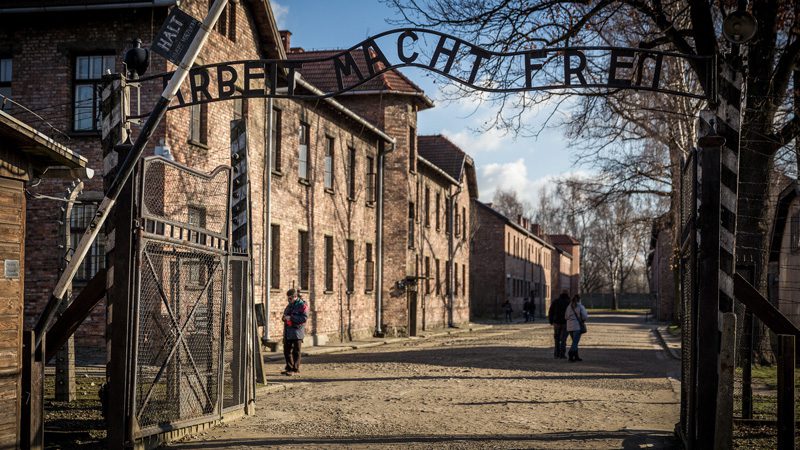
A couple of years ago, my girlfriend and I were hostelling our way through central Europe. We’d made it to Berlin, which is a little like those crossroads in movies, the ones with a dozen signs pointing in every possible direction.
There were too many choices as to what to do next. We could head north into Denmark, west to the Netherlands and Belgium, or south into the Czech Republic.
“What about Poland?” my girlfriend said. “We could see Auschwitz.”

The drive from Krakow
A couple of days later I was bouncing along in a small bus through the green lanes of southern Poland, just outside Krakow. The driver didn’t speak any English, nor did the other four sullen Poles on board. When we mentioned the word Auschwitz the driver just grunted and gestured to the seats.
The drive from Krakow to the old camp doesn’t take long. After thirty minutes we stopped on a road like any other road. A few of us got off and the bus rumbled away. Opposite was a shady boulevard lined with birch and oak trees. Glance up and you could just make out the red bricks and roofs of Auschwitz I, the original camp built by Polish political prisoners in the early 1940s.
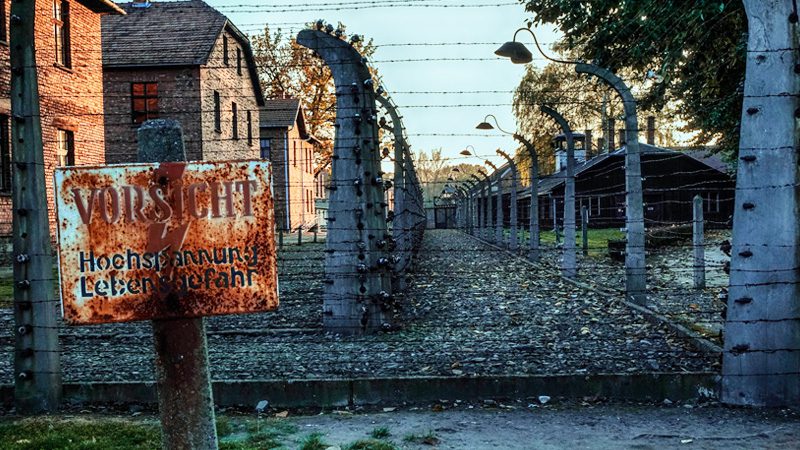
Auschwitz I. Image Thomas Hee, Flickr
Auschwitz I
On busy days, over 30,000 tourists will walk through the grounds of Auschwitz. Dozens and dozens of tours run simultaneously through the old camp and Birkenau, a few minutes down the road. As such, they run a pretty efficient ship. When you arrive you sign up for a tour time and are equipped with a pass, headset and radio. Your guide has a microphone and a transmitter, so all you need to do is tune in to their frequency. You begin where so many prisoners once did, beneath the rusted metal words “Arbeit macht frei” (work makes you free).
The next few hours are hard to describe. Your guide leads you through the avenues and neat brick houses of Auschwitz I. There are bare dormitories, old corridors, chilly parade grounds and – everywhere – double lines of razor wire poles, each equally spaced from its neighbour, and arched in a candy cane curve.
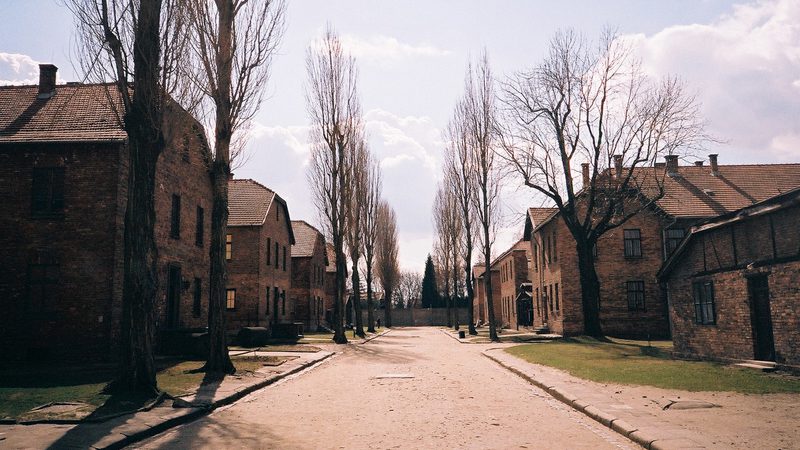
Image c/o Monica Kelly, Flickr
In every room, rows and rows of faces stare out from the walls: old prisoner profiles in black and white. Most look blank and empty; they portray nothing. But studying them is worth the price of admission alone. You could look at the eyes for hours, searching for a glimmer of hope, a pang of fear or a hint of determination. You can’t help but wonder what they were thinking.
Your guide says, “Three weeks after these were taken, all these people were dead.”
Every piece of the place has a story attached. Here a room, three feet by three feet, where four men were made to stand in the dark until they died. There the square outside notorious Block 11, the prison within a prison, where inmates were routinely executed against a brick wall. The house of the camp commandant, Rudolf Hoss, and the gallows where he was executed by the Allies in 1947. The gas chambers, the piles of hair, glasses, shoes… children’s toys.
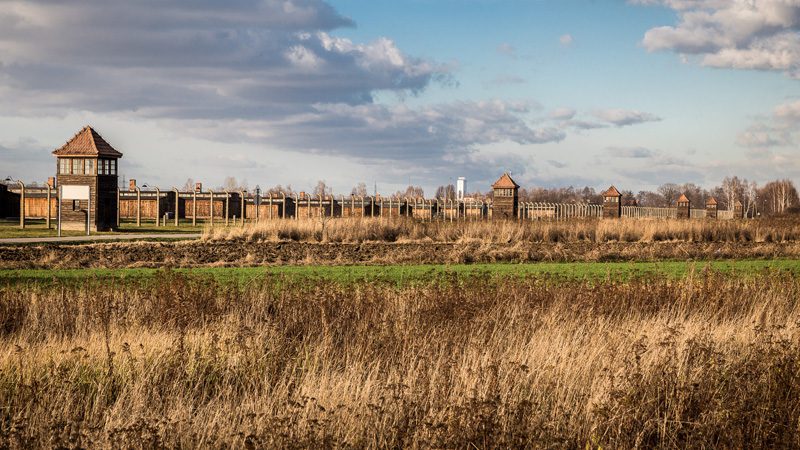
The fields of Birkenau. Image Mattia Panciroli, Flickr
Tourism in Auschwitz has attracted some criticism in recent years (the alleged ‘death tourism’) but I don’t really buy into it. You can criticise the actions of individuals, sure, but I think educating and illuminating future generations on one of the darkest times in human history can only be a good thing. Just like Winston Churchill said: “Those who do not learn from history are doomed to repeat it.”
After the original camp, the tour moves to Birkenau, which is an experience in itself. The close streets and heaviness of Auschwitz I are replaced by acres of grass, clear skies and two parallel railway tracks that come to an ominous, and very final, stop. There’s a warped tranquillity in Birkenau. Yellow wildflowers grow beneath the guard towers. You can see nearby villages and rolling hills. There’s the warble of distant birdsong. It’s hard to imagine that up to 20,000 people per day were killed and burned here. Apparently the nearby residents, the ones who hadn’t been rounded up in the first few years of Nazi occupation, could see and smell the smoke for miles. They slept with the distant glow of the ovens outside their window.
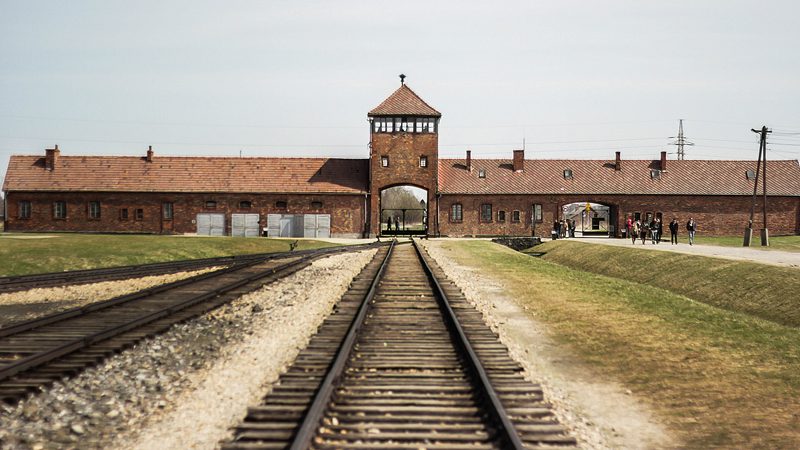
Image c/o Nick Perrone, Flickr
A visit to Auchwitz is the difference between reading the music and hearing it played. You can read about the horrors that happened there, watch documentaries that give you all the facts, but until you stand in the gas chambers, hear the eerie silence around the ash pools of Birkenau and see the dusty wooden bunks where prisoners would huddle together – you won’t understand it.
At the end of the tour you’re left standing outside the red brick main entrance to Birkenau. I remember thinking how quiet the place was. Even with so many people in it. there was so much silence in that place.
Travellers can visit Auschwitz on some of our trips through Poland . All entry fees to the World Heritage Site go towards preserving the camp for future generations.
Feature image c/o Matti Panciroli, Flickr

Feeling inspired?
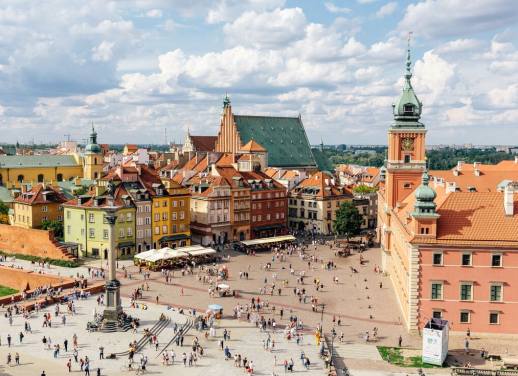
James Shackell
I was born in 1987 and aged from there. I like the sound of pop-rocks and dislike the sound of styrofoam. The length of my forearm is approximately the same as the length of my shin. My favourite Beatle is Ringo. I believe that junk food tastes so good because it’s bad for you and that your parents did the best job they knew how to do. If Johnny Cash wrote a song about my travels it would be called ‘I’ve been to several places but still have many other destinations on my to-do list, man’. Sometimes I have trouble finishing sen
You might also like
The 7 best places to go on a..., 10 surprising facts about ethiopia, galapagos or madagascar which unique destination should be..., travelling to chile here’s the best time to..., 10 reasons to visit samoa, the 10 antarctica questions you want answered, australia or new zealand where to go on..., 10 epic spots to stop at on your..., small group travel vs coach tours: which is..., costa rica or mexico: which country to check..., 7 of the best destinations for solo travellers....
- South Africa
- El Salvador
- Bosnia and Herzegovina
- North Macedonia
- Czech Republic
- Transnistria
- Liechtenstein
- North Cyprus
- New Zealand
- Map with posts
- Alternative Guides
- Architecture Guides
- Cafe Guides
- Itineraries
- Neighborhood Guides
- Travel Guides
- Travel Tips
- Photo Galleries
- Photo Locations
- Solo female travel
- Train Travels
- Work with me
- Privacy Policy
Visiting Auschwitz – How to Plan the Auschwitz Tour
Visiting Auschwitz, albeit a very somber experience, is one of the must things to do in Poland. The largest Nazi Germany concentration and extermination camp during World War II, where over 1,3 million people lost their lives, needs no introduction. Conveniently located near Krakow , Auschwitz can be an easy addition to your Poland itinerary.
It took me almost 37 years to finally visit Auschwitz (although I’ve been to other Nazi Germany camps in Poland), and even if I knew very well what to expect, the place still overwhelmed me with its cruelty and tragedy. And I think everyone should plan a trip to Auschwitz to understand history better and see what people are capable of when the ideology brainwashes them. And, of course, to pay respect to all the unnecessary victims. It’s important to visit places like Auschwitz so we can do our best to prevent similar tragedies from happening in the future.

If you are visiting Poland (especially Krakow , Warsaw , Katowice , or Wroclaw ), I prepared this guide to help you plan your Auschwitz tour without too much hassle. There are different ways to visit Auschwitz, but no matter which one you choose, be prepared for one of the most difficult yet necessary travel experiences of your life.

Table of Contents
Where is Auschwitz
The former Nazi Germany Concentration Camp, Auschwitz-Birkenau, is located in a town of around 37.000 inhabitants called Oświęcim in southern Poland. Krakow is less than 70 km away, and Katowice is 35 km away. Warsaw, the capital of Poland, is around 330 km away from Oświęcim.
A brief history of Auschwitz
Even if Auschwitz is known mainly as the extermination camp, it was established as a concentration camp in mid-1940. It was one of over 40 camps in Poland that were supposed to be a solution to the problem of overflowing prisons full of arrested locals. The first people were brought to Auschwitz on June 14th, 1940, from the prison in Tarnow.
Since 1942 Auschwitz has also been used as the extermination camp where Nazis implemented their plan to murder Jewish people from all over Europe. At the peak of its operation, in 1944, Auschwitz was divided into three parts: Auschwitz I (the oldest one, in the old Polish military barracks), Auschwitz II-Birkenau (the largest one, founded in 1941, the majority of victims were killed here), and Auschwitz III (this was a group of over 40 sub-camps created near industrial plants, made for work prisoners).
Numerous Polish villages were demolished, and locals were evicted to develop such a large institution. The camps were isolated from the outside world. The total area was around 40 square kilometers, including all three Auschwitz camps and the so-called “interest zone” used for the technical or supply background, offices, and barracks for Nazis.
Since Auschwitz had a strategic location on the front line, in August 1944, the camp’s liquidation began – the prisoners were taken to Germany, and the evidence of the crimes was covered up. The liberation of Auschwitz took place on January 27th, 1945, when around 7,5 thousand prisoners were still held there.
Altogether, in the almost four years of operation, over 1,3 million people lost their lives in Auschwitz; the majority were Jewish (around 1,1 million), but also Polish (about 150 hundred thousand), Roma people (23 thousand), and other nations.
In 1979 Auschwitz was included in the UNESCO World Heritage List – it is the only former Nazi concentration camp with that title in the world.
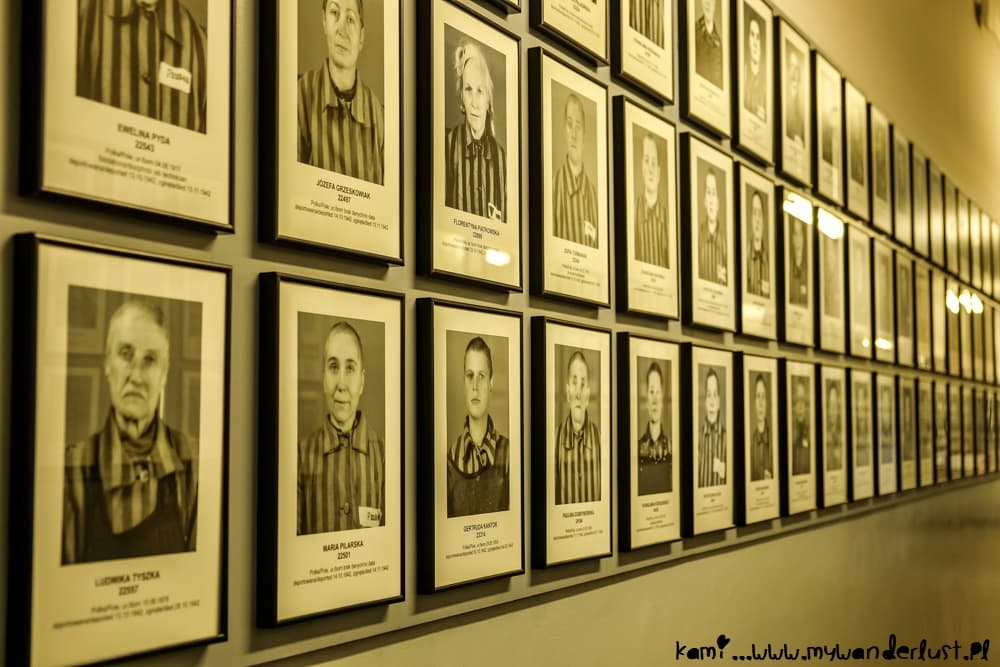
How to visit Auschwitz
You can visit Auschwitz two ways: with a tour from where you are staying in Poland (most likely Krakow, Katowice, Warsaw, or Wroclaw) or independently, reaching the site by car or using public transport. Both options are doable; however, the tour is a slightly better one as everything will be taken care of for you.
There is a wide selection of tours to choose from that depart from Krakow as well as other mentioned cities. Most of them cover more or less the same things: pick-up from your accommodation, transportation to/from Auschwitz and back, the entrance ticket to the concentration camp, and the guided tour on-site.
When I visited Auschwitz, I arrived by train from Warsaw, with the change in Katowice. I was at the museum almost an hour before my guided tour of the site was supposed to start, and despite the poor weather (it was raining on that day), there was no place to hide and wait for the tour. Visitors were not allowed to enter the museum until a few minutes before the tour was about to start. Me and a few other unlucky visitors just stood near the trees, hiding under the umbrella and waiting for our time to enter the site. I can’t say it was a comfortable situation (but at least the weather worked perfectly well for such a sad place to visit). Recently, a new visitors center was opened so hopefully the situation is better.
When using public transport, you need to rely on the schedule of trains/buses and, just in case, plan to be at the site with some extra time ahead; hence a tour is a better option. Still, visiting Auschwitz is doable independently – I did it, and once the tour of the site started, it was really good.

Visiting Auschwitz – practical information
Visiting Auschwitz memorial site is free of charge; however, I recommend joining the tour with the educator provided by the museum. They have a huge knowledge of the place and the tragedy that occurred here and can answer all the questions visitors always have. Tours are available in various languages: Polish, English, German, French, Spanish, Italian, Russian, Czech, and Slovak.
Even if you decide to visit the site independently, you still need to book the entry pass – those with free entrance start in the afternoon. You can buy/reserve your ticket online at the website of Auschwitz Museum here.
Currently, the price for the tour with the educator is 80 PLN for Polish and 90 PLN for other languages. When booking the ticket, you must state your full name and surname – this will be checked later.
Since tickets can sell out quickly, booking one at least a month in advance is recommended. If there are no tickets left for the day you want to visit Auschwitz, you can join the organized tour from Krakow or other cities, as tour operators usually have tickets booked in advance. Due to the sensitive nature of the place, children under 14 years old should not visit Auschwitz Museum.
Once you have your ticket, you need to arrive at the Auschwitz visitors center 30 minutes before your tour starts to go through the security check (it’s rather thorough, similar to the airport), have your ticket inspected (remember to have the ID or passport with you), get the headset for the tour and meet your group. You are allowed to have a bag or backpack with a maximum dimension of 30x20x10 cm; any larger luggage must be left in the paid lockers.
Auschwitz Museum is open every day except January 1st, December 25th, and Easter Sunday. Opening hours vary depending on the month and are as follows:
- 7:30-14:00 in December
- 7:30-15:00 in January and November
- 7:30-16:00 in February
- 7:30-17:00 in March and October
- 7:30-18:00 in April, May, and September
- 7:30-19:00 in June, July, and August
The closing time means the last entrance – after that, you are allowed to stay on-site for an hour and a half. However, if you want to see Auschwitz Museum properly, you need at least 3,5 hours for that – that’s also how long the standard tour with the educator lasts. It is usually divided equally between Auschwitz I and Auschwitz II- Birkenau. A free shuttle bus runs between the two sites every few minutes.
Taking pictures and making videos is allowed in Auschwitz, for individual use, except in two places: the hall with the hair of Victims (block nr 4) and the basements of Block 11. Your educator will remind you not to take pictures there.
Remember what sort of place you are visiting and behave there with respect. It might be obvious for most, but I can’t count how many times I’ve read news about inappropriate behavior in Auschwitz and other similar sites in Poland, so I think it’s worth reminding this is not your typical tourist attraction but a place of one of the greatest tragedy that ever happened in the world.

Getting to Auschwitz independently
If you decide to visit Auschwitz on your own, you must get to the visitors’ center, where your tour will start. The new visitors center, which opened just recently, is located at 55 Więźniów Oświęcimia Street in Oświęcim ( here is the exact location ). If you drive there, there is a large parking lot where you can leave your car before visiting the museum.
If you use public transport, there are both trains and buses you can take to reach Oświęcim. I recommend trains as they are slightly faster and more comfortable; however, some buses stop next to the museum, so that’s convenient. You can check all the connections on this website , where you can also find the location of the bus stop in Oświęcim (there can be three different ones).
The train station in Oświęcim is located at Powstańców Śląskich Street, some 20 minutes walking from the Auschwitz museum. It’s a straightforward way; you can check the map with the directions here . I recommend catching the train that gives you at least an hour between arriving at Oświęcim and when your tour starts.

Auschwitz tour from Krakow
Numerous Auschwitz tours depart from Krakow, so you will easily find the one that suits your itinerary and needs. Here are some recommended ones:
- Auschwitz-Birkenau Museum and Memorial Guided Tour from Krakow
- Auschwitz & Birkenau – Fully Guided Tour from Krakow
- Auschwitz-Birkenau Guided Tour with Private Transport from Kraków
- Auschwitz-Birkenau Guided Tour by Private Transport from Krakow
You can also combine visiting Auschwitz with Wieliczka Salt Mine , another UNESCO-listed site near Krakow and a must-visit place in Poland. Here are the tours that go to both places in one day:
- Day Trip to Auschwitz-Birkenau and Wieliczka Salt Mine from Krakow including Lunch
- Full-Day Tour of Auschwitz and Wieliczka Salt Mine from Krakow
- Auschwitz-Birkenau and Salt Mine Tour with private transport from Krakow
- Combined: Auschwitz Birkenau and Salt Mine private chauffeur from Krakow
If you decide to go to Auschwitz from Krakow on your own, you can take the train from the main train station to Oświęcim. They are rather frequent, more or less every hour, and the journey takes a bit over an hour (depending on the connection, the longest one is 1h20min).
If you want to take the bus, they depart from the MDA bus station, next to the main train station. The price for trains and buses is similar, between 15 and 20 PLN, although trains tend to be cheaper and faster. You can check all the connections and buy a ticket here .

Auschwitz tour from Warsaw
Even if Warsaw, the capital of Poland, is located over 300 km away from Oświęcim, it is possible to go for a one-day Auschwitz tour. However, you can expect a long day, and a large part of it will be spent traveling. But if you are visiting Warsaw only, Auschwitz can be a good addition to your Poland itinerary, so you can better understand the country’s complex history.
Here are some of the recommended Auschwitz tours from Warsaw:
- From Warsaw Auschwitz and Krakow one day tour by train with pick up and drop off
- One day tour to Auschwitz-Birkenau from Warsaw with private transport
Going for the day trip from Warsaw to Auschwitz independently is also possible using trains. You can take the 6 am train to Katowice and then change for the train to Oświęcim, arriving in the town around 10:30. If you decide to do that, you can book your Auschwitz tour for 11:30 or 12:00. On the way back, you can catch the train after 16:00 from Oświęcim to Katowice, and after changing for the train to Warsaw, you will be in the capital after 20:00.

Auschwitz tour from Katowice
Since Katowice is less than 40 km from Auschwitz, it’s easy to go for a day trip. You need to take the local train to Oświęcim, it takes less than 50 minutes, and the connections are more or less every hour.
Or you can go for a tour, here are the Auschwitz tours from Katowice:
- Auschwitz – Birkenau from Katowice
- Auschwitz & Birkenau English guided tour by private transport from Katowice
- Auschwitz tour from Wroclaw
Wroclaw is another popular place to visit in Poland, and since it’s located around 230 km from Oświęcim, you can go for an Auschwitz tour from Wroclaw too. If you decide to do it independently, you can take the train to Katowice and then change for the local train to Oświęcim. A one-way trip should take you less than 4 hours.
Or you can go for a tour; here are the recommended ones from Wroclaw:
- Auschwitz-Birkenau Tour from Wrocław
- Private Full-Day Tour to Auschwitz-Birkenau from Wroclaw
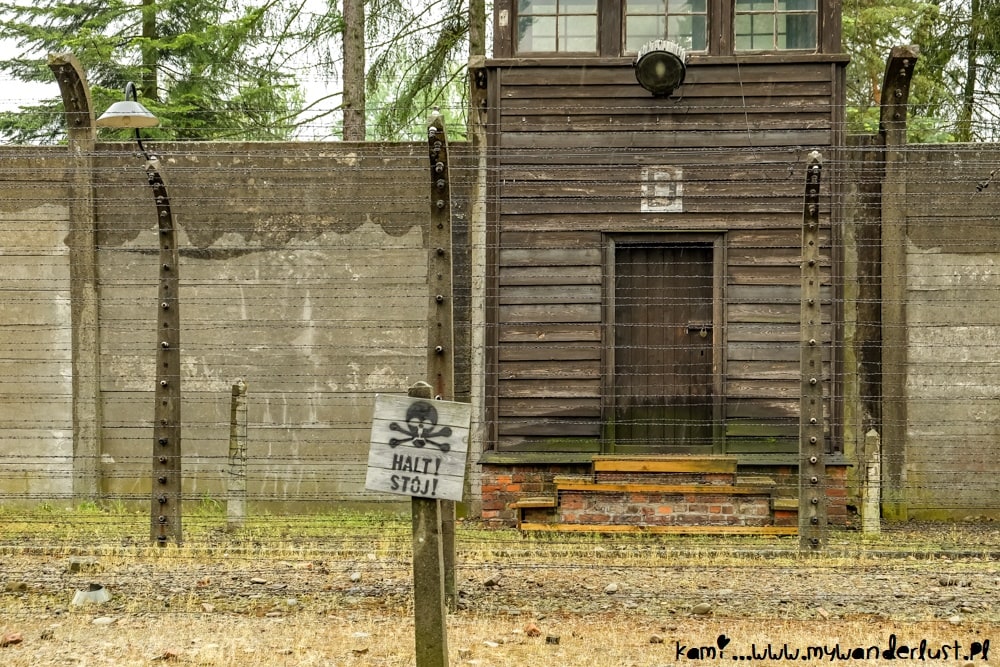
Auschwitz Museum Tour
As for the museum itself, here is what you can expect.
You will start in the oldest part of the concentration camp – Auschwitz I, where the infamous gate with the sign “Arbeit macht frei” (meaning “Work Sets You Free”) is located. Here, you will visit numerous barracks where inmates were kept – now you can see different exhibitions there, showing the reality of Auschwitz and halls with personal belongings taken from arriving prisoners – luggage, shoes, glasses, etc., or hair of Victims. You will learn all about cruel practices here, including medical experiments or torture.
Visiting this part of Auschwitz museum is a very somber experience, and it’s really difficult to comprehend the tragedy that happened in this very place.
Besides the barracks in Auschwitz I, you will also see where the camp commander lived or the first crematorium where Nazis started their experiments with killing using gas. In this part of the Auschwitz tour, you can take pictures everywhere except the two places in Blocks 4 and 11 – they will be clearly marked, and your educator will remind you about this restriction.
The visit to Auschwitz I takes around 1,5 hours. Afterward, together with your group and educator, you will take the shuttle bus to Auschwitz II-Birkenau, located some 3 km away.

Auschwitz II-Birkenau is where around 90% of victims died. It is a huge area that worked kind of like the killing factory, with four gas chambers and crematoriums. This is also where most prisoners arrived – you most likely know the view of the railway tracks and brick gate – that’s Auschwitz II-Birkenau. This part of the visit is mostly outdoors.
You will walk around the area, see the remnants of the camp, visit some barracks inside, and learn all about the horrific tragedy that happened here. When Auschwitz I has a more intimate, even claustrophobic feeling, Auschwitz II-Birkenau can overwhelm you with its scale and enormity.
You will spend around 1,5 hours here, too; afterward, you can take the shuttle bus back to the visitors center when you started your tour.
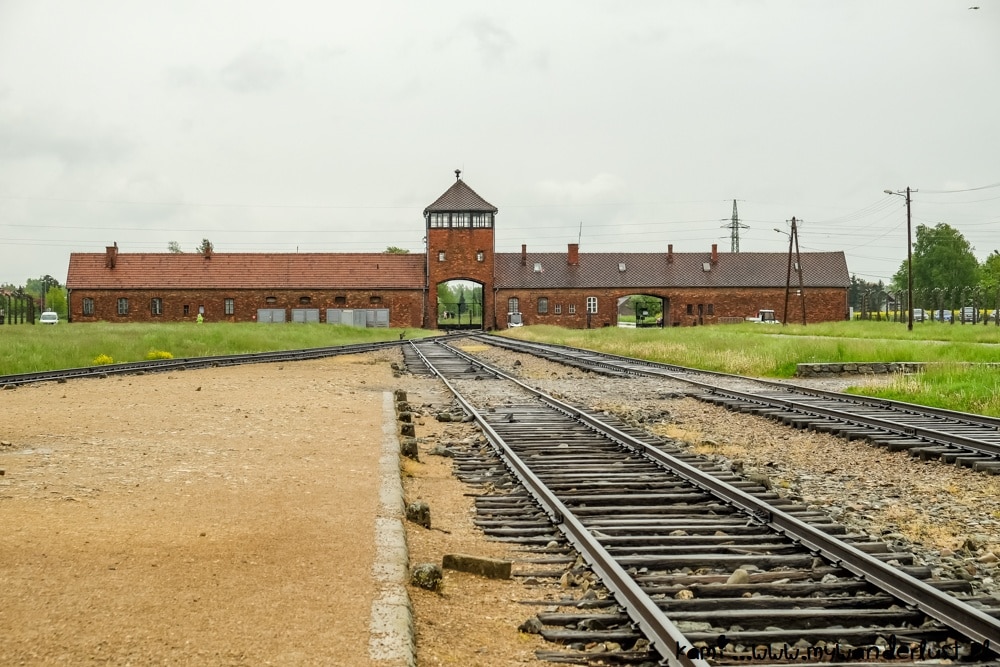
Final thoughts on visiting Auschwitz
Even though I’ve lived in Poland almost my whole life, and Auschwitz has been a familiar topic since I remember, it took me nearly 37 years to finally visit the place. Before I was in different Nazi Germany sites in Poland, mostly in Majdanek in Lublin, so I didn’t feel the need to visit Auschwitz too. But I don’t regret the decision to go there eventually.
You can read and learn about the place, but nothing can prepare you for visiting Auschwitz. Some areas look familiar (after all, pictures of the “Arbeit macht frei” sign or Birkenau gate are present everywhere), but you will still be overwhelmed by the place and seeing it in real life. It’s hard to comprehend the cruelty and tragedy that happened here, and dealing with all the thoughts invading your mind afterward can take a while. It can be one of the most difficult-to-understand places you will ever visit.
Still, despite it all, I think everyone should go to Auschwitz to see where fanaticism and totalitarianism can lead and why we should avoid them at all costs.
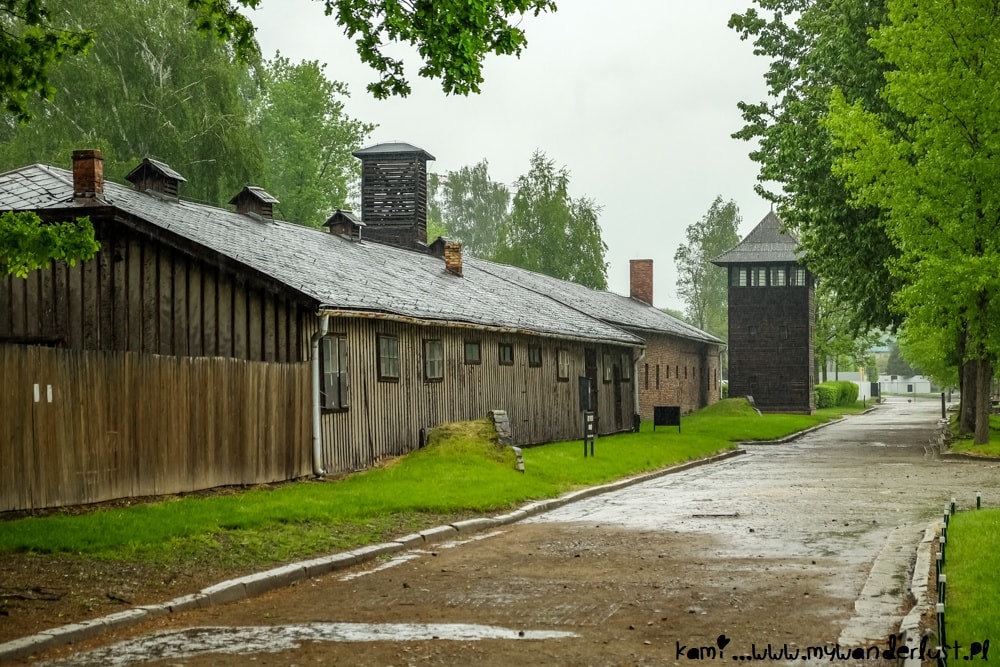
Further reading
I published many articles about Poland that you might find useful when planning your trip there. Here are some of them:
- 37 Amazing Things to Do in Krakow, Poland
- 20 Great Places to Visit As Day Trips from Warsaw, Poland
- 17 Amazing Things to Do in Lublin, Poland
- The Complete Guide to Visiting Slownski National Park, Poland
- Visit Grudziadz – One of the Hidden Gems of Poland
- 19 Amazing Things to Do in Gdansk, Poland
- Visit Sandomierz, Poland – One of the Prettiest Towns in the Country
- Visiting Malbork Castle, Poland – the Largest Castle in the World
- 25 Amazing Things to do in Wroclaw, Poland
- and many more!
If you are looking for articles about a specific destination – check out the map with all the articles I’ve published (and their locations). You can also join my Facebook group about traveling in Central Europe and ask your questions there.
Travel Resources
You can find the best accommodation options at Booking . They have many discounts and excellent customer service. Click here to look for the place to stay in Poland
Never travel without travel insurance , you never know what might happen and better safe than sorry. You can check the insurance policy for Poland here.
I recommend joining organized tours to get to know the place better and to visit more places during your trip. You can find a great selection of tours at Get Your Guide – click here .
For the end I left a few announcements that might interest you:
- Sign up to my newsletter or follow me on Bloglovin to get updates about the new posts
- Join my Facebook group about Eastern Europe, the Balkans and former USSR and connect with fellow travellers and enthusiasts of these regions – just click here!
- I’ve included a few handy links of services and products I personally like and use so you can plan your own trip to Poland too. They are often affiliate links. This means I will get a small commission if you book/purchase anything through my links, at no extra costs for you. Thank you!
LIKED IT? PIN THIS POST FOR LATER!
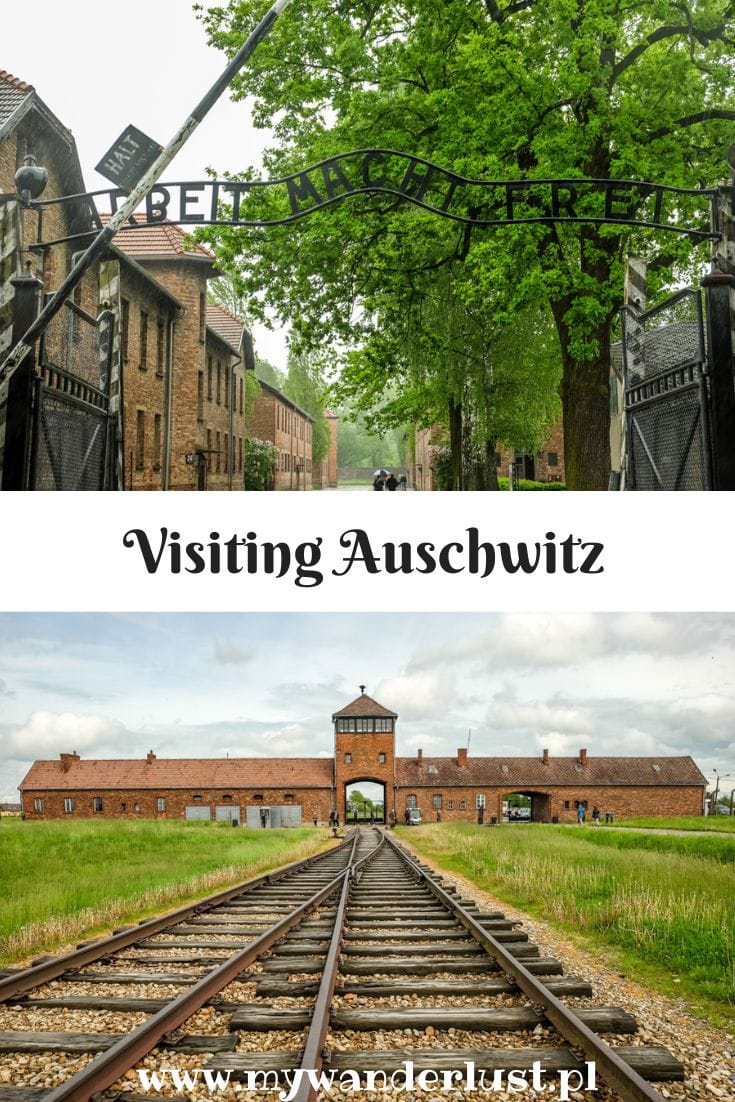
If you enjoyed that post why don't you share it with your friends? That would mean so much to me! Also be sure to join 30.000+ fellow travelers and follow me on Facebook , Twitter , or Instagram for travel updates and even more pictures! If you don't want to miss new posts sign up to my newsletter or follow on Bloglovin !

No Comments
Leave a reply cancel reply.
Sign me up for the newsletter!
Let’s become friends!
Join me on Facebook for even more travel updates!
Kami and the rest of the world
Deals of the Week Solo is the new black Up to 50% OFF
Tours & Trips including Auschwitz 2024/2025
Find the right tour for you through Auschwitz. We've got 111 adventures going to Auschwitz, starting from just 3 days in length, and the longest tour is 28 days. The most popular month to go is August, which has the largest number of tour departures.
111 Auschwitz tour packages with 1,200 reviews
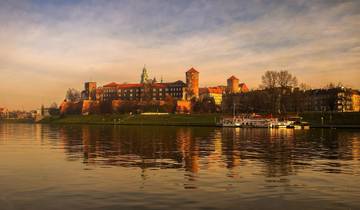
- In-depth Cultural
- Christmas & New Year
Krakow, Auschwitz & Wieliczka Salt Mine - 4 Days
Highly recommend this tour.
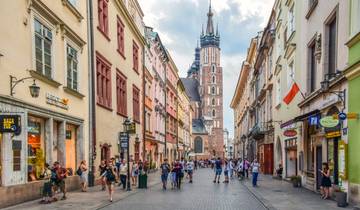
Krakow & Auschwitz
I felt like I was the only person involved in this "group" tour. When I booked this I was under the impression I would be with a group. I never met a consistent guide or any other consistent person on the same activities. It seemed like the accommodations and tours were arranged for me through TourRadar/Euroadventures. But quite honestly, I could have done that myself with better accommodations.
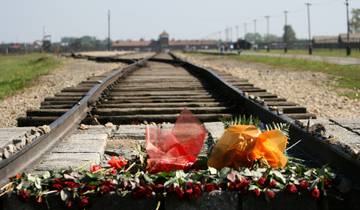
Krakow, Auschwitz, Enamel Factory & Wieliczka Salt Mine - 4 Days
Fantastic tour although the Salt Mine I would skip on my next trip. Our guide Seweryn was the best. He made everything so real and down to earth. He gives you so much information. I Would recommend him to everyone. Twice as good with him as our guide Great trip we visit again.
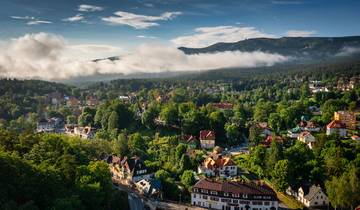
- Coach / Bus
Highlights of Southern Poland
The Poland tour was excellent! The group leader Beata was awesome and all guidance, planning and itinerary was wonderful. Totally recommended!!

- Sightseeing
Pearls of Poland (for couples)
I think this tour is just right for covering the best sites in Poland in a week's time. I doubt few travelers know anything about Poland's history. So a brief outline of the essentials at the start of the tour would facilitate understanding in Warsaw and Krakow. Our guides were excellent, but if they had structured their presentations, they would have communicated the details at the sights visited much better. Since we two were the only tourists on this tour in this Covid-marred year, we traveled with a driver (Piotr) who was tops.

6 days in Krakow and Szczawnica- private exclusive tour for 2 people
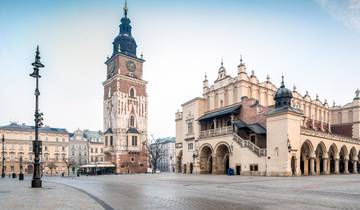
7 days in Krakow and Szczawnica- private exclusive tour for 5-8 people

Highlights of Poland
Well done to our tour guide Justyna and well done to Explore for putting this on in difficult times.
- 10% deposit on some dates Some departure dates offer you the chance to book this tour with a lower deposit.

Highlights of Poland (Classic, 10 Days)
The trip was great. All the things we saw were awesome. Poland is a lovely country. The hotels were all 4 or 5 star -- very nice. And the coach was excellent -- with 2 doors for more efficient boarding, and a toliet for emergencies. The guides were great too.

Tailor-Made Private Trip to Southern Poland with Daily Departure
- Book With Flexibility This operator allows you to rebook your dates or tours with them for free, waiving change fees.

Portrait of Poland
Overall, the tour was wonderful. A lot was squeezed into the 7 days. There were a few stops we would like to have spent more time at. The evening included meals were average or below average- it would have been nice to have more local cuisine. Breakfast meals were good; the breakfast buffet at the Regent Warsaw Hotel was excellent. Our tour guide Kasia was very knowledgeable & engaging - she did an excellent job! Really enjoyed her commentary & she was so helpful.

- Walking Adventure
Best of Poland (11 Days)
Everything was outstanding. Coach, Kate (tour guide), all other guides (except one), hotels, meals, itineraries, driver, sights, tours. Two issues. Our Auschwitz tour guide had a very, very pronounced accent and spoke very quickly making it difficult to understand him. Extremely knowledgeable but needs to slow down his speech. Loved that every tour guide throughout the country was a "local". The other issue was that the optional tours available were charged in Euros and not Polish money. Other than those "minor issues" the tour was truly outstanding, interesting, educational and fun!
- €100 deposit on some dates Some departure dates offer you the chance to book this tour with a lower deposit.
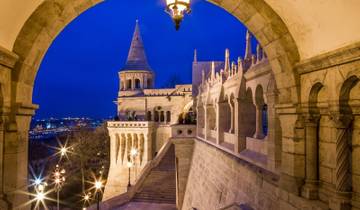
Best of the East
It was good we enjoyed

Tailor-Made Private Poland Tour with Daily Departure

Highlights of Poland (Small Groups, 10 Days)
What people love about auschwitz tours.
Seweryn was a fantastic tour guide and very knowledgeable about Krakow's history. I enjoyed learning about the many historical and religious details we saw around Krakow. He also went above and beyond to help me when I had trouble purchasing train tickets, and when I got sick offered to reschedule one of the tour days. I really enjoyed his tour and would highly recommend it.
Did their Krakow, Poland trip in December during the Christmas markets. Really a great trip and experience. Everything was very organized, had really good hotel near the square/old town (I booked the 3-star hotel, private room option with my husband), guides were very good & knowledgeable and the excursions/tours were very good. We also received a lot of extra information and recommendations for things to do and places to go (food and drink too) in our free time which was really nice and helpful. I was a bit nervous reading a few of the reviews here on Yelp but our experience was fantastic and nothing like what some others wrote in their reviews. Krakow was an amazing city and one of the most beautiful in Europe. Definitely recommend this trip and company.
I had a great first time experience of Krakow through this tour. My tour guide Seweryn was very friendly, flexible, organised and helpful and made the whole process very smooth. The trips to the mine, factory and camps were well laid out and gave me plenty of time for independent sightseeing and fun. If you want to come to Krakow I would highly recommend you do a trip this way!
Auschwitz Tours - Day Tours

- See all photos

Similar Experiences

Most Recent: Reviews ordered by most recent publish date in descending order.
Detailed Reviews: Reviews ordered by recency and descriptiveness of user-identified themes such as wait time, length of visit, general tips, and location information.
Auschwitz Tours - Day Tours, Krakow

At Auschwitz march, participants rally around concern over hostages and antisemitism
O ŚWIĘCIM, Poland – A shofar call rang out at Auschwitz on Monday, signaling the start of the annual commemorative march by thousands of Jews to Birkenau, part of the former Nazi death camp, situated about 2 kilometers (1.2 miles) away.
Yet instead of the solemn silence that usually characterizes this moment of the March of the Living through the camp near Krakow, the shofar prompted a burst of chants by dozens of students from Canada.
“Bring them back,” chanted members of the Canadian delegation, sandwiched between the Belgian and the Panamanian ones, as they began to march. They held up posters of hostages held by terrorists in Gaza, and the chants spread across the delegations, triggering applause from participants.
This strong focus on the aftermath of October 7 at the start of this year’s Holocaust commemoration event at Auschwitz, held on Israel’s Holocaust Remembrance Day, continued to define the event throughout.
It reflected both Israel’s centrality to how Jews commemorate the Holocaust, and the incorporation of the trauma felt by many Jews over October 7 into the greater, defining one caused by the Nazi genocide.
The International March of the Living, the nonprofit that organizes the march at Auschwitz for Jewish youth movements and others, acknowledged the event’s focus on October 7, when about 3,000 Hamas-led terrorists murdered some 1,200 people in Israel and abducted 252.
This year’s March of the Living, in which some 8,000 people participated, “holds profound significance, as the horrors of the past intertwine with the present ongoing nightmare faced by […] Israel,” Phyllis Greenberg Heideman, the president of International March of the Living, said in a statement.
October 7 determined much of the content at the event, as well as the main controversy — a small anti-Israel protest staged by nine activists along the march’s route.
On stage, during a closing ceremony that followed the march, six Israeli Holocaust survivors whose lives were directly affected by the October 7 onslaught lit one of seven commemorative torches.
Usually, there are only six torches — one per million Jews murdered in the Holocaust — but organizers added a seventh in recognition of the October 7 onslaught and its victims.
Daniel Luz, a France-born survivor of both the Holocaust and October 7, spoke to the participants, telling them he recalled feeling a “fear greater even than in the Holocaust” as Hamas terrorists murdered people and burned homes in his Kibbutz Be’eri community.
He said that he and the other survivors lit the torch for the victims of both the Holocaust and of October 7, his voice cracking with emotion.
Other torch lighters included Rabbi Yisrael Meir Lau, a former chief rabbi of Israel who survived the Holocaust in Poland; Marc Schneier, a promoter of Jewish-Muslim dialogue from the US, and Doron Almog, the chairman of the Jewish Agency for Israel.
Also attending the march were relatives of hostages and former hostages held in Gaza, including Thomas Hand, whose daughter Emily was abducted and later released in a November deal.
En route to the ceremony, a handful of protesters with Palestinian flags and a sound amplification system staged the first anti-Israel rally in the March of the Living’s 36 years of existence.
They accused Israel of perpetrating “another genocide,” speaking from a parking lot overlooking the halfway point of the march.
Wearing keffiyehs around their necks or on their faces, the protesters shouted to the marchers, who were mostly not Israeli: “Are you not ashamed of what your government is doing?”
The main organizer of the protest, Alena Palichleb, who said her father is Palestinian and whose mother is Polish, lectured the marchers on how they should behave at Auschwitz.
“What are you cheering for? Why are you waving flags here? This is a cemetery, the epicenter of a genocide, show some respect! Your mothers are watching!” she shouted.
She told The Times of Israel: “You should see the mess and dirt that Israeli visitors leave here.”
The marchers, who often sing Hebrew-language songs about revival during the procession that celebrates the Jewish people’s survival, responded with a thunderous rendition of the Israeli national anthem and jeers. “There’s no such thing as Palestine,” one marcher shouted until another hushed them and told them to “avoid provocations.”
Several Polish policemen surrounded the anti-Israel protesters. One police officer told The Times of Israel the protest was legal and pre-approved.
Alena’s father promised this reporter that “we will return to Palestine.”
He added: “October 7 was the beginning of our role, of our country to be free, Palestine,” adding: “We have nothing against Jews.” Palestinians, he also said, “would never accept a Jewish state, but also not an Islamic state, only a democratic state.”
The man also seemed to suggest that Hamas terrorists treated hostages kindly and that reports of atrocities were made up by mainstream media.
Bella Haim, a Holocaust survivor at the march whose grandson Yotam was abducted to Gaza by Hamas and killed there accidentally by Israeli troops, called the protest “shocking.”
It was “a vivid display of what we hear about, the antisemitism out of control on campuses all over the West,” she said.
In a statement, the International March of the Living wrote: “The half a dozen protestors who perversely saw this as an opportunity to voice hatred against Israel and the Jewish people serve as a timely reminder of the importance of Holocaust eduction and remembrance.”
One of the dozens of Muslim marchers at the event, Youssef Elzahari, also condemned the protest.
“They just tried, unsuccessfully, to hijack an event commemorating the murder of six million people. I’m not sure what they think they’re achieving,” said Elzahari, 30, from Marrakech, Morocco. He was a member of a delegation from the Sharaka nonprofit, which promotes ties between Israel and Arab- and Muslim-majority countries.
Also participating were members of a delegation from Atidnah, which focuses on Arab-Jewish understanding in Israel. They wore shirts emblazoned with the logo of their group and the Israeli flag.
The many students at the march said that campus antisemitism and anti-Israel vitriol, which exploded after October 7, strengthened their resolve to unite and fight back, and also attend the march.
“It’s all part of the same thing: The hostages were abducted for the same reason people were murdered here: for being Jewish,” one student from Canada, Evelyn Gorodetzky, told The Times of Israel.
She called the situation on campuses “terrible” when asked about antisemitism there. “But we’re vocal and we fight,” said Gorodetzky.
Benjamin Signer, an 18-year-old high school student from Los Angeles, was supposed to travel from Poland to Israel, along with other participants in the march from his Jewish school. But the Israel leg was canceled after October 7, he said. “It’s disappointing but it makes this experience, which to me is about Jewish unity, even more significant,” he said of the march.
The unity he sees, Signer added, “is important because of the isolation we feel as Jews right now. It gives strength going forward in life.”
The post At Auschwitz march, participants rally around concern over hostages and antisemitism appeared first on The Times of Israel .
Never miss important Israel stories - get the free Times of Israel Daily Edition

- Sign Up / Log In
Create a free profile to get unlimited access to exclusive show news, updates, and more!
The Tattooist of Auschwitz References Real-Life Prisoners Who Escaped The Camp
The Tattooist of Auschwitz references some of the thousand prisoners who attempted escape. The ones who survived changed the world forever.
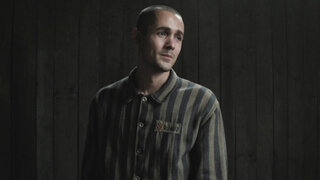
The Tattooist of Auschwitz is a searing historical and biographical drama about one of the grimmest place in history. But at the center of the series is prisoner Lali Sokol , a tattooist who falls in love with fellow prisoner, Gita, and their eventual escape from the Nazis. However, theirs isn't the only harrowing story of survival to come out of Auschwitz-Birkenau.
Their love story brings hope to the horror and is based solely on Lali's recollection several years later. Through the six-episode series, now streaming on Peacock, we learn about other rare moments that provided glimmers of hope to the prisoners as they experienced the unimaginable.
One scene in particular illustrates that spirit of triumph: When Gita (Anna Próchniak) learns that prisoners have escaped, she believes they’ll tell the world what is happening. While The Tattooist of Auschwitz is a dramatic recreation of real-life events — based on Heather Morris’ famous book — there were certainly hundreds of brave people who attempted escape, and some who made it to safety. Here we'll explore just some of the Auschwitz escapes that brought fellow prisoners hope.
How Many Prisoners Escaped Auschwitz?
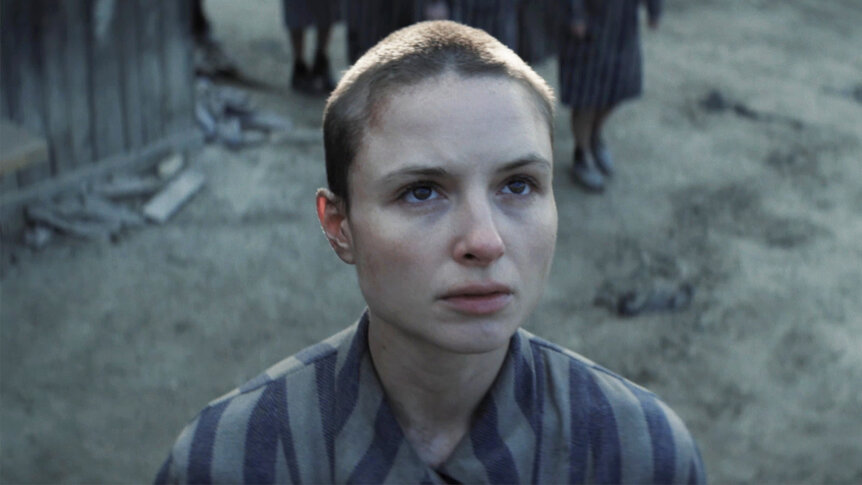
The very first escape came in July, 1940 not long after Auschwitz opened in southern Poland as the largest of the Nazi death camps.
It’s estimated that a total of 196 prisoners successfully escaped the camp, and according to the Auschwitz-Birkenau Memorial and Museum, the majority lived to see the end of the war. However, about four times as many prisoners were thwarted, with some 732 prisoners captured, killed, or simply disappeared. Those brave souls who risked all came from many different backgrounds, including Jews, Poles, Russians, as well as some Romani and Czech.
Approximately 1.1 million prisoners, or about 85 percent of people sent to Auschwitz during World War II, did not survive their internment. Just before the closure of the camp in 1945, nearly 60,000 prisoners had been “evacuated” west on death marches, with tens of thousands losing their lives along the way. When liberation day arrived in January 1945, there were some 7,000 prisoners at the camp.
How Did the Auschwitz Prisoners Escape?
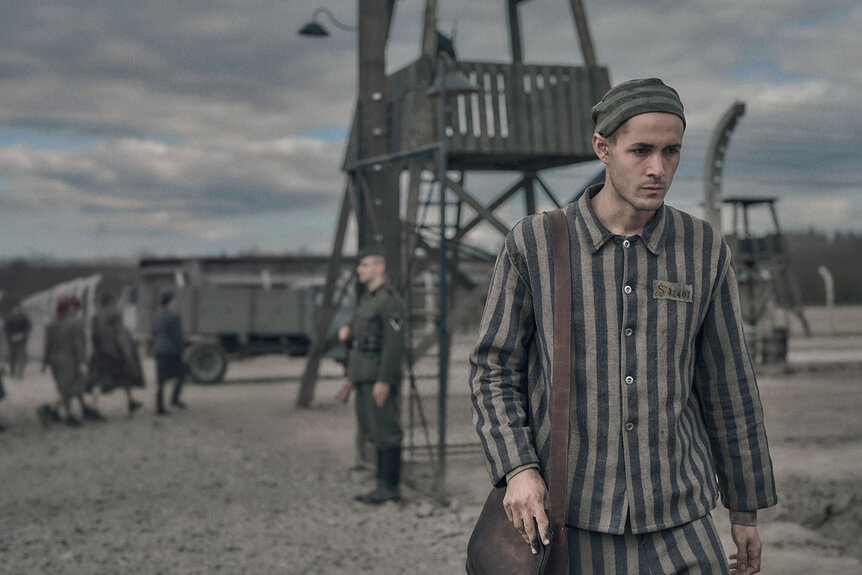
Most prisoners were smuggled out by clandestine resistance movements in German-occupied Poland, hiding out in people’s homes until the end of the war. An underground resistance movement inside the camp also assisted with escapes. Prisoners often disguised themselves as guards, donning SS uniforms, and left camps in horse carts or vehicles they had cleverly commandeered from the Nazi motor pool. Others escaped while working at the coalmines or for the notorious German chemical company IG Farben, which forced 30,000 prisoners from Auschwitz into slave labor.
The escapees risked more than just their lives if they were caught. SS Soldiers often murdered anyone suspected of helping, tracking down family members and sympathizers outside of the camp who were waiting for them or willing to help. Unfortunate prisoners who were suspected of assisting the escapees were often brutally interrogated before being murdered, according to the Auschwitz-Birkenau Memorial and Museum.
The Escapees Changed the Course of History
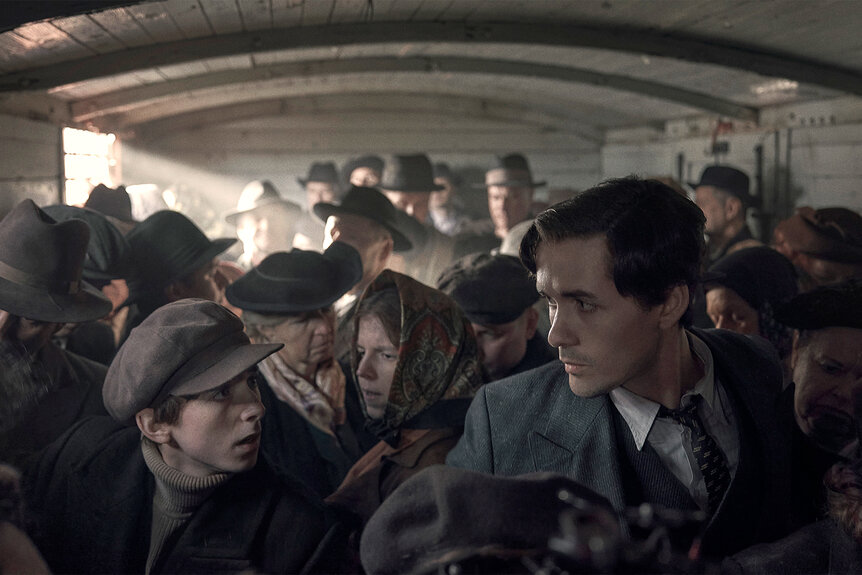
Remarkably, at the peak of the war, the existence of the Nazi camps was barely known to the broader world, but two escaped Jewish prisoners would change all that.
On April 7, 1944, Walter Rosenberg, 19, and Fred Wetzler, 25, hid in a hollowed-out spot within a woodpile at Auschwitz, spreading tobacco-soaked gasoline around their hideout to mask their scent from dogs. After four days of searching, the Nazis gave up, and the two prisoners escaped, intent on warning Hungarian Jews about the death camps — the last major intact Jewish community in Europe.
Rosenberg and Wetzler traversed forests and treacherous terrain for eleven days to reach their home country of Slovakia. There, they created the first detailed account of Auschwitz ever written, the Vrba-Wetzler Report. It was released in the summer of 1944 and prompted international outcry, changing the course of history forever.
While the escaped duo's story is not told outright in The Tattooist of Auschwitz, even Gita and Lali felt the hope that stemmed from their escape and the promise that the world would soon find out what the Nazis were doing to the Jewish people. In the end, rescue never came for them and it was up to each other to find their way out of their horror. But like Lali and Gita's story, history won't forget people like Rosenberg, Wtzler and countless others who succeeded or attempted to escape Auschwitz.
All six episodes of The Tattooist of Auschwitz are available to watch on Peacock.
- The Tattooist Of Auschwitz
Related Stories
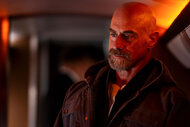
Law & Order: Organized Crime Season 5 Moves To Peacock

Ted Prequel Series Renewed for Season 2 on Peacock
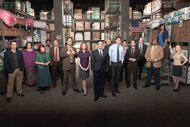
Peacock Orders Series Set in Same Universe as The Office: Everything to Know
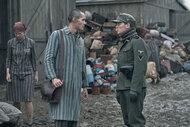
Jonas Nay on Coping With His “Deeply Disturbing” Character
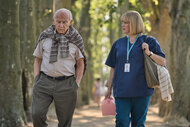
Melanie Lynskey Reveals What She Learned About Heather Morris

Mayhem of 1990 Yankees on Display in Peacock Doc
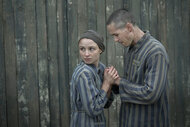
How The Tattooist of Auschwitz Creators Portrayed Lali's Memories
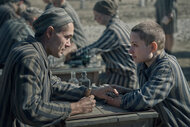
More Heather Morris Books Like The Tattooist of Auschwitz

How to Watch the 2024 Kentucky Derby on NBC and Peacock

Kevin Hart, Kenan Thompson to Host Olympic Highlight Show
What’s new on peacock in may 2024.

Melanie Lynskey on Why Her Husband Keeps Proposing to Her
Recommended for you.

2-Year-Old Mariska Hargitay Appears on the Merv Griffin Show
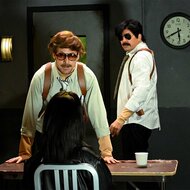
Ryan Gosling and Jimmy Fallon Deserve Oscars for Playing Identical-Looking Tough Cops

Scarlett Johansson Matches Katie Britt's SOTU Energy in SNL Parody: Watch
- - K-town Now
- Asia-Pacific
- - Storm Tracker
- Middle East
- Map of Memorials
- Entertainment
- - Video Games
- Europe Travel
- - Quick Trips
- - After Hours
- Pacific Travel
- The Meat and Potatoes of Life
- U.S. Travel
- Storm Tracker
- Rewards for readers
- Get Stripes
- Stripes Lite
- Archives/Library
- Special Publications
- Mobile Apps
- Email Newsletters
- Digital Access
- Home Delivery
- Marine Corps
- Coast Guard
- Space Force
- Archive photo of the day
- - Schedules Europe
- - Scoreboards Europe
- - Schedules Pacific
- - Scoreboards Pacific
- - Pacific Sports Blog
- - WW II Podcast
- - Military Matters
- - Force for Hire
- Out of Uniform
- - WW II Videos
- Communities
- Stripes Europe
- Stripes Guam
- Stripes Japan
- Stripes Korea
- Stripes Okinawa
- Our Other Websites
- In Memoriam
- Month of the Military Child
- Best of Germany
- Best of the Pacific
- Letters to Santa
Tours from Europe bases

Oodles of Polish pottery awaits shoppers as Kaiserslautern Outdoor Recreation offers a trip to Krakow, Auschwitz and Polish pottery shops June 13-17. (iStock)
Base tours offer an easy way to see Europe with other members of the military community. Here is a sampling of trips scheduled as of May 10, 2024. Please update this information and add tours by sending an email to Marcus Klöckner at [email protected].
SHAPE TRIPS AND TOURS: Call 06544-3884. Email [email protected] or visit www.shape2day.com.
ANSBACH OUTDOOR RECREATION: May 18, Neuschwanstein castle area, $579 adults, $139 children ages 3-11, $119 children ages 2 and under; May 23, Costa Brava (Spain), $449 adults, $399 children ages 3-11, $199 children ages 2 and under; June 5, sunset paddling with ODR, $25 adults, $5 children ages 12 and under; June 13-17, Paris, Normandy, $439 adults, $389 children ages 3-11, $149 children ages 2 and under. DSN 467-3225/CIV 09802-83-3225 or MWR Central DSN 467-1780 or CIV 09802-83-1780.
BAUMHOLDER OUTDOOR RECREATION: May 11, Keukenhof, tulip gardens, $129 adults, $119 children; May 11, Black Forest tour, $79 adults, $49 children; May 12, Baden-Baden, spa day, $75; May 19, Tongeren (Belgium), antique market, $79; June 1, Champagne tour Epernay (France), $149. DSN 485-7182 or CIV 06783-67182.
GRAFENWOEHR OUTDOOR RECREATION: May 11, Mother’s Day fishing event, $29 adults, $19 children; May 25, fishing season opener, $20-$25; June 7-9, fishing course, $65 adults, $40 children ages 10-18; June 15, Father’s Day fishing event, $20 adults, $10 children. DSN 314 475-8529 or CIV 09641-83-8529
KAISERSLAUTERN OUTDOOR RECREATION: May 23-27, Croatia, $1,329-$1,469, $269-$949 children; May 23-27, Memorial Day weekend in London, $1,049 adults (single room), $829 adults (double room); May 24, Normandy and Omaha Beach, $749 adults (single room), $599 adults; June 14-17, Prague weekend, $549 adults (single room), $49 adults (double room), $349 children ages 11 and under; June 13-17, Krakow, Auschwitz and Polish pottery, $799 adults (single room), $629 adults (double room), $479 children ages 11 and under, $229 children ages 2 and under. DSN 493-4117 or CIV 0631-34064117.
RTT TRAVEL RAMSTEIN: May 10-12 and June 5-7, Prague and Karlovy shopping, 459 euros adults (single room), 369 euros adults (double room), 299 children ages 3-11; May 11, June 8, July 27, Candy Coated Cologne, May 12, Mainau Island, 129 euros adults, 109 euros children ages 3-11, 99 euros children ages 2 and under. CIV 06371-463650 or see www.RTTtravel.com.
RTT FLIGHT TOURS/RAMSTEIN: Call 06371-463650 or see www.RTTtravel.com.
SPANGDAHLEM INFORMATION, TICKETS AND TRAVEL: DSN: 452-6567 or CIV 06565-61-6567.
STUTTGART OUTDOOR RECREATION: May 11, MWR adventure tour: Hirschgrund Zipline, $120 adults, $105 children ages 12-16; May 18, MWR adventure tour: white water rafting, $200 DSN 431-2774 or CIV 0703-2774.
WIESBADEN OUTDOOR RECREATION: June 14-17, Berchtesgaden, $459 adults, $399 for children ages 3-11, $299 children ages 2 and under; July 3-7, $799 adults, $739 for children ages 3-11, $599 for children ages 3 and under; July 16-Oct. 5, hunting course, $269. DSN 337-5760 or CIV 06117-055760; email usarmy.wiesbaden.imcom-eurospe.list.mwr-outdoor-recreation@mail.mil.
Netherlands
SCHINNEN: (+31) (0) 46-443-7561 or DSN 360-7561 or email [email protected].
ROTA OUTDOOR RECREATION: May 18, canyon descending; May 24, Almunecar, multi-adventure trip; June 1, Los Alcornocales, hiking Garganta del Capitin; June 8, canyon descending; June 15, Bay of Cadiz, sailing and windsurfing, $100; June 18, night kayak & Sancti Petri castle tour, $85; June 22, Los Corrales Beach, stand-up paddle board & kayak, $60 July 6, Tarifa, quad tour, $130; July 13, canyon descending, $85. Outdoor Recreation (ODR)DSN 727-3101 or CIV 095682-3101/3208.
ROTA ITT: May 11, Los Patios in Cordoba, $40; May 18, Sevilla historical tour, $70 adults, $55 children ages 2-14; May 25, Ronda, $35.Tickets and Travel; June 1, Torremolinos (Malaga), self-guided tour; June 1, Sanlucar Feria de Manzanilla, bullfight, June 8, Ubrique historical tour; June 22, Malaga, historical tour and Nerja Caves. DSN 727-3101/3208 or CIV 095682-3101/3208.

Sign Up for Daily Headlines
Sign up to receive a daily email of today's top military news stories from Stars and Stripes and top news outlets from around the world.
Sign Up Now

The Tattooist of Auschwitz is controversial, but is historical accuracy more important than awareness?
Associate Professor in Modern European History and Jewish History, UNSW Sydney
PhD Candidate, UNSW Sydney
Disclosure statement
Jan Lanicek receives funding from the Australian Research Council. He is a co-president of the Australian Association for Jewish Studies.
Rebecca Cordony receives funding from the Australian Government's Research Training Program (RTP) Scholarship and is the 2024 Research Fellow at the Women in the Holocaust International Study Centre.
UNSW Sydney provides funding as a member of The Conversation AU.
View all partners
This month, the much-anticipated television adaptation of The Tattooist of Auschwitz premiered on Australian streaming platform Stan. Before its release, significant publicity announced it as an all-star production : Melanie Lynsky and Academy Award nominee Harvey Keitel in leading roles; an original score by Academy Award winner Hans Zimmer; an original song written and sung by Barbara Streisand. The series has been applauded as a “courageous, unforgettable, human story” and as both “a love story and reminder of the Holocaust and its horrors”.
The book on which the series is based was published in 2018 by the Australia-based, New Zealand-born author Heather Morris . The Tattooist of Auschwitz has been translated into more than 40 languages and sold millions of copies worldwide. It tells the story of Ludwig “Lali” Sokolov (né Eisenberg), as recounted to Morris over three years of personal meetings.

A Slovakian Jew, Sokolov was transported in 1942 to Auschwitz-Birkenau. He was eventually assigned the role of Tätowierer at the camp, tattooing individual prisoner numbers on the forearms of thousands of new arrivals. While tattooing, Lali met Gita Fuhrman, also a Jewish deportee from Slovakia, and the pair instantly fell in love. “I tattooed her number on her left hand, and she tattooed her number in my heart,” Lali told Morris .
Both survived almost three years in Auschwitz and, after a period of separation, were reunited in Slovakia. Lali and Gita married and, in 1949, emigrated to Melbourne, where they raised their son and made a new life for themselves.
Following the success of The Tattooist of Auschwitz, Morris released a sequel Cilka’s Journey (2019), and later Stories of Hope (2020) and Three Sisters (2021), adding to an ever-expanding genre of stories of love and hope set in Auschwitz – one that includes works such as Roxane van Iperen’s The Sisters of Auschwitz (2019), Ellie Midwood’s The Girl who Escaped from Auschwitz (2021), Keren Blankfeld’s Lovers in Auschwitz (2024) and Lidia Maksymowicz’s A Little Girl in Auschwitz (2023).
The six-part television adaptation of The Tattooist of Auschwitz, directed by Tali Shalom-Ezer , joins a well-established genre of cinematic representations of Holocaust histories focused on love stories that includes Sophie’s Choice (1982), Life is Beautiful (1997) and The Reader (2008).
Based on – or inspired by?
Despite its international success, the book of The Tattooist of Auschwitz generated a lot of controversy. The main criticism related to its historical inaccuracies.
Morris initially claimed 95% of the account was factual. She insisted she had only fictionalised scenes where she put Lali and Gita “ into events where they really weren’t ”. Historians remained sceptical. They soon revealed Morris had uncritically relied on Sokolov’s account, failing to verify key details. Some reviewers even claimed she had intentionally and unethically manipulated Sokolov’s testimony .
Relatives of some of the characters, including the couple’s son Gary Sokolov, felt uneasy with the final version. The stepson of Cilka Klein, the main protagonist of the sequel to The Tattooist of Auschwitz, threatened Morris with a lawsuit.
The Auschwitz Memorial published the most scathing response. In a painstaking review, Wanda Witek-Malicka listed historical inaccuracies , including even minor errors that border on nitpicking, starting from a wrong prisoner number tattooed on Gita’s hand and extending to the book’s simplified and unlikely depiction of a relatively free prisoners’ life in the camp.
Witek-Malicka concluded that the book should “be perceived as an impression devoid of documentary value … only inspired by authentic events”. She did not recommend the book as a “valuable title” for those who “want to explore and understand the history of KL Auschwitz”.
But why is it so problematic to make a fictional story containing historical inaccuracies about the Holocaust? If we can make a fictional story about other historical events, featuring real characters, why not the Holocaust? Its history is well-known; everybody recognises the gates of Auschwitz and the gas chambers as ultimate symbols of inhumanity. Authors publish scores of fictional accounts set within a fictionalised version of the Holocaust each year and they do not elicit such heated debates. One gets the impression that Morris became the victim of her success, which made her mistakes more visible.
Samantha Mitschke , a Holocaust theatre scholar, opposed the criticism, arguing that The Tattooist of Auschwitz “is a novel, not an affidavit … A novel is meant to convey emotions”.
Television critic Robert Lloyd made a similar point about the adaptation, suggesting that “the re-creation of Auschwitz feels trustworthy”, but observing that “we’re looking at the past through a scrim of art … it’s a translation of a work of fiction based on a memory of an experience; a filtered reality, and only a slice of it”.
Historical distortions
The main concerns here are Holocaust distortion or outright denial, especially in the approaching post-witness era. Morris’s critics believe that authors who write about the Holocaust have a special responsibility to do proper fact-checking.
Morris, and to a degree the television series, put real historical characters and events into fictional encounters, and in doing so use several Holocaust clichés. The aim is to achieve a dramatic effect, but also to make the story look “real”. The Tattooist of Auschwitz balances on the line between facts and fiction, which for some makes the events seem credible, but for others discredits the whole effort.
The Tattooist of Auschwitz is not the first Holocaust book and film to be criticised for historical distortions. Steven Spielberg’s film Schindler’s List (1993), particularly the shower scene in Auschwitz , attracted criticism that it could fuel Holocaust denial. Other blockbusters, including Life is Beautiful and Boy in Striped Pyjamas (2008), have been rejected by historians for containing what they regard as dangerous and unethical historical inaccuracies.
The television adaptation of The Tattoist of Auschwitz partially shields itself from criticism of its historical accuracy. A disclaimer at the opening of each episode reminds the audience the story is based on Lali’s memory and aspects have been fictionalised. Countless faces of the victims Lali encountered in the camp appear on the screen as reminders of those who did not make it. The device of jumping between present and past also draws attention to the issues of testimony, trauma and survivor guilt.
The authors of the screenplay have corrected some of the major mistakes from the original version of Morris’s book. They have also changed the structure of the plot. In the screen version, we listen to the story through old Lali, who invites Morris to his apartment and shares his memories. This allows the authors to acknowledge the possible inaccuracies and gaps in his testimony.
As Morris patiently listens to the gruesome details from the camp life, Lali makes mistakes, sometimes intentionally. He corrects himself, or tells Morris to keep parts off-record. He is haunted by his memory, which he tries to manipulate, omitting details about his involvement in Nazi crimes. To save Gita, for example, Lali abetted the murder of prisoners by Dr Schumann, a character based on the notorious Josef Mengele.
The depictions of survivor trauma and troubled memories have been praised as the strongest part of the series . The depiction of the camp is also visually promising, and the narrative is largely well dramatised by the actors, especially Keitel as the older Lali.

The danger of trivialisation
The audience is constantly reminded that The Tattooist of Auschwitz is a love story. Such is the focus on the love between Lali and Gita that the complex history of the Holocaust comes dangerously close to functioning as a well-recognised mise-en-scène. The striped uniforms, box cars, barracks, abuse, starvation and death form the backdrop to a story of courage and hope with a redemptive, triumphal ending.
The educational value of the history is, in this way, subordinated to entertainment. But what if such fictionalised blockbusters, simplified though they are, do more for Holocaust awareness than meticulously researched Holocaust documentaries?
The Auschwitz Memorial complained that after the publication of Morris’ book, visitors began to ask for special tours in the footsteps of the tattooist. Did the book bring them to the museum? Isn’t this the role popular culture should play? Its job is not primarily to educate, but to raise awareness and generate interest that will lead people to educate themselves.
Criticism of popularised Holocaust representations is certainly not new. The debate has been active since the late 1970s, when it was provoked by the premiere of the CBS television miniseries Holocaust: The Story of Family Weiss (1978). The series was based on reality, but was essentially a soap opera, a Hollywood version of events with many inaccuracies.
Some Holocaust scholars and survivors were offended at the trivialisation, arguing that the Holocaust was a singular event, beyond representation. Famous Holocaust survivor Elie Wiesel stated:
Auschwitz cannot be explained, nor can it be visualised. The Holocaust transcends history. […] The Holocaust [is] the ultimate event, the ultimate mystery, never to be comprehended or transmitted. Only those who were there know what it was, the others will never know.
But there were those who disagreed. The miniseries brought the Holocaust to audiences well beyond scholars. It made the history broadly accessible for the first time. Showing that history, even with inaccuracies, allowed audiences to begin to construct their own understandings and meanings of a complex past. This may lead to the conclusion that it is better to show something of the Holocaust, an approximation of what happened, than nothing at all.
The impact of the Holocaust miniseries cannot be understated. Half a billion people worldwide viewed it. It allegedly encouraged a Papal visit to Auschwitz, contributed to the creation of the President’s Commission on the Holocaust (leading to the opening of the US Holocaust Memorial Museum in 1993), and encouraged Germany to extend the statute of limitations on war criminals.
Many film scholars credit the miniseries with pushing cinematic representations of the Holocaust forward, for better or worse. Major films followed, including Schindler’s List and Life is Beautiful, which proved equally divisive. They were critically acclaimed, but criticised for stereotyping, inappropriate use of humour, and presenting love stories against a backdrop of death.
At the climax of the first episode of The Tattooist of Auschwitz, when the audience is finally rewarded with seeing the young lovers meet, “ romantic music swells on the soundtrack and, as they temporarily part, they both smile. For half a second, we almost forget where we are ”.
Is this a trivialisation or a distraction from the reality of history? Does the love story serve as misdirection or mediation that moves us away from the totality and reality of the Holocaust? Or does it perhaps provide an entrance point – a recognisable narrative device that allows audiences to engage with the Holocaust, at least in some way?
Stories in which love and courage triumph over the ultimate evil may be problematic, but they don’t discourage audiences from watching them in the way a more brutal depiction might. And is this not the overarching imperative? Never look away? Never again?

Trauma and the ambiguity of survival
Responding to the premiere of the television series, the Auschwitz Memorial was quick to release another statement . It emphasised that “immortal love” would not be enough for Lali and Gita to survive almost three years in Auschwitz-Birkenau. Both were lucky to get lighter job assignments, which meant they did not have to labour in the fields, exposed to the elements and brutal kapos.
The book and television series both raise the uncomfortable issue of privileged prisoners in Auschwitz, Lali among them. The SS created a hierarchy, which gave functions to some of the prisoners in exchange for better working and living conditions. Lali, as a tattooist, had his own private room and better food. According to the book and series, he even developed a close, albeit strange, relationship with one of the SS men, Stefan Baretzki. “To me he was like a brother,” Lali said in his USC Shoah Foundation interview in 1996.
These scenes were criticised as unrealistic. But others have noted that close though bizarre relationships could develop between the SS and veteran prisoners. Morris, for example, includes a story about a football game between a prisoner team (headed by Lali) and the SS.
This scene was omitted from the series. Yet in his famous essay The Gray Zone in The Drowned and the Saved (1986), Primo Levi, a prominent voice among Holocaust survivors, mentions a similar game between the SS and the Sonderkommando , a Jewish unit that operated the crematoria. For Levi, this was the ultimate example of inhumanity and the “most demonic plan” of the SS: “we have embraced you, corrupted you, dragged you to the bottom with us”.

Lali is troubled by his status as a privileged prisoner who works for the “ Politische Abteilung ” (Camp Gestapo): “I can only hope I am one day not judged as a perpetrator or collaborator.”
These scenes, and the trauma depicted in the series, remind us about the difficult histories of the Holocaust, and of survival in extremis. Survivors, such as Lali and Gita, carried the burden of survival for the rest of their lives.
While Holocaust film and popular literature production has not stagnated, the debate launched in the 1970s appears to be at an impasse. Morris’s book and its television adaptation show that the interest in representing this aspect of the human experience, ultimately to achieve the goal of entertaining and captivating audiences, shows no signs of abating.
If we accept this, perhaps it is the responsibility of educational institutions, museums and memorials to use these productions as learning opportunities – certainly providing correctives where necessary, but most of all maintaining critical engagement with an audience who has already shown a willingness to engage with the Holocaust in some way.
- Book adaptations
- Holocaust narrative
- Holocaust literature

Events and Communications Coordinator

Assistant Editor - 1 year cadetship

Executive Dean, Faculty of Health

Lecturer/Senior Lecturer, Earth System Science (School of Science)

Sydney Horizon Educators (Identified)

The Michigan Daily
One hundred and thirty-three years of editorial freedom
‘Music from Auschwitz’ debuts before SMTD European tour
Share this:.
- Click to share on Twitter (Opens in new window)
- Click to share on Facebook (Opens in new window)

About 30 U-M students and community members gathered at Britton Recital Hall Tuesday night to hear ‘ Music from Auschwitz ,’ a performance of 10 musical pieces composed by Polish political prisoners from the Auschwitz I men’s orchestra. None of the pieces have been performed for an audience since they were played in the Auschwitz-Birkenau concentration camp between 1940 and 1945.
Each of the original pieces and arrangements were prefaced by quotes from their composers. Rising Music, Theatre & Dance senior Jack Morin, a vocalist, recited a testimony by Ralph Maria Siegel, a Jewish composer and Auschwitz survivor. The testimony mentioned how prisoners of Auschwitz would perform for the SS, or Schutzstaffel , which were Nazi guards later charged for leading the “Final Solution”, or the mass murder of European Jewish people.
“‘After our concert for the SS we had a 30-minute break,’” Morin recited. “‘Then we would play for the prisoners in the yard by the camp kitchen. They certainly would have preferred something to eat but almost half of them came to listen, thousands of them.’”
Patricia Hall, professor of music theory at the Music, Theatre & Dance School, first began to bring the work of these composers to life in 2016. In an interview with The Michigan Daily, she said her interest in the manuscripts began when she read about musical scores commissioned by the SS and written by Jewish composers that contained unique instructions on how to play in the likely event that members of the ensemble were murdered.
“I read a book by Simon Laks , who was one of the conductors in Auschwitz,” Hall said. “He talked about this special notation he was forced to use because so many of his ensemble members were suddenly sick or they were dead, and so I became curious if there might be manuscripts in the Auschwitz-Birkenau State Museum .”
From there, Hall said she traveled to Poland and delved into the archives of the Auschwitz-Birkenau State Museum, looking to discover more about these orchestrations.
“I got an appointment, and I went there not expecting to find anything,” Hall said. “Instead, I found literally hundreds of pages of manuscripts that no one had ever studied before, and I was immediately drawn to this one piece, ‘The Most Beautiful Time of Life,’ because I just could not imagine a title like that in Auschwitz. Even though I knew nothing about the music, I decided I just had to realize that piece.”
Pam Oatis, a community member, sat in the audience with her husband, John Kiely. In an interview with The Daily, Oatis said she was moved by the juxtaposition between the harrowing postwar testimonies of the composers and the cheerful nature of the music they had written at that time.
“I’ll quite honestly say I cried through most of it,” Oatis said. “Just the horror of what humans could do to one another, yet (at the same time) have parties, and how the prisoners would rather have gotten food but thousands came to hear the music. (It shows) there’s something about the therapy of music. I mean, what does music do for us? It lifts us out of horror to joy.”
Hall told The Daily the original goal behind retrieving the manuscripts was to produce recordings for the Auschwitz-Birkenau State Museum .
“My idea was that we could make a recording for the archive,” Hall said. “So they could actually hear what this ensemble sounded like because there are lots of thoughts about these ensembles … but no one really knows what they sounded like (because) there’s no recordings.”
In an interview with The Daily, Music, Theatre & Dance graduate Margot Cunningham, a viola player in the ‘Music from Auschwitz’ orchestra, said the project eventually expanded to a tour of concerts in 2020 but was halted due to the pandemic.
“We were actually supposed to do the project back in 2020,” Cunningham said. “We had a US tour and a Europe tour, but because of COVID, the Europe tour got canceled … Then, Professor Hall reached out to us three years later and asked us if we wanted to do the European tour.”
This performance is considered a “launch” concert for the European tour taking place this summer. About 20 Music, Theatre & Dance students and faculty will travel to Vienna, Austria and Kraków to debut music orchestrated by Jewish artists who were local to these cities before being sent to Auschwitz.
Hall said she hoped holding these concerts in the cities the composers were from would greatly impact the members of those communities today.
“The audience we’re going to perform for is at the Jewish Museum in Vienna, and the Jewish population of Austria was decimated during World War II, (and likewise) when we go to Kraków there will be a similar audience there,” Hall said. “So I think this is going to be very special for them to hear this music.”
Cunningham said the Music, Theatre & Dance School plans to visit Auschwitz while they tour across Europe, which she hopes will help the musicians connect with the music on a deeper, more emotional level.
“We’re going to be touring Auschwitz, and seeing where the orchestra played,” Cunningham said. “It’s just gonna be so powerful … I don’t know what it’s gonna feel like, but I’m very grateful to be part of it.”
Daily Staff Reporter Anna Javier can be reached at [email protected] .
Related articles
The Definitive Voice of Entertainment News
Subscribe for full access to The Hollywood Reporter
site categories
‘the tattooist of auschwitz’ review: melanie lynskey and harvey keitel in peacock’s harrowing holocaust drama.
An 80something Holocaust survivor relays his memories of Auschwitz, including his romance with a fellow prisoner, in a miniseries adapted from Heather Morris' 2018 bestseller.
By Angie Han
Television Critic
- Share this article on Facebook
- Share this article on Twitter
- Share this article on Flipboard
- Share this article on Email
- Show additional share options
- Share this article on Linkedin
- Share this article on Pinit
- Share this article on Reddit
- Share this article on Tumblr
- Share this article on Whatsapp
- Share this article on Print
- Share this article on Comment

The Tattooist of Auschwitz has a distinctive way of way of marking death. Each time someone passes, the drama pauses on a moving portrait of their face in life, against the grim toll of a bell. Sometimes, it’s how we learn a character we’ve been following for several episodes has been killed. At others, it’s the only good look we get at people whose names we never even learn before they’re slaughtered.
Related Stories
How 'tattooist of auschwitz' leads sparked onscreen chemistry for holocaust love story, barbra streisand sings closing credits song for 'the tattooist of auschwitz', the tattooist of auschwitz.
But the gravity of a noble mission can also become an albatross. In spite of the touching romance at its heart, The Tattooist of Auschwitz feels like a means of conveying an urgent message, rather than a story to get swept up in for its own sake.
The self-conscious morality of The Tattooist of Auschwitz is most strongly reflected in creator Jacqueline Perske’s choice to include as a character Heather Morris (a wasted Melanie Lynskey), the writer who will go on to pen the 2018 novel that inspires this very drama. She is the audience surrogate, leaning in with care and curiosity as concentration camp survivor Lali (Harvey Keitel, congenial and heartbreaking) relays his extraordinary saga. She also serves as our conscience, repeatedly stressing how “important” this tale is. After one session lands her in the hospital with a panic attack, she insists to her husband that she must nevertheless press on. “None of the things Lali went through, none of it happened to me,” she says. “And to make it about me would be a bloody insult.”
Her comment lands as a reproach to viewers who might be in their own feelings about Lali’s harrowing account, though by that point — four episodes in, out of six — it’s likely plenty will have tuned out already, unable to stomach its graphic horrors. By the bleak standards of the camp, Lali (played by Jonah Hauer-King as a younger man) is luckier than most. His job etching numbers into the arms of fellow prisoners grants him some minor perks and a modicum of freedom.
And that’s just in the first hour (directed, along with the rest, by Tali Shalom-Ezer). Subsequent chapters bring beatings and rapes, shootings and hangings, suicides and cruelly thwarted attempts at same, set to Hans Zimmer and Kara Talve’s somber score. The Tattooist of Auschwitz ‘s saving grace is that they also bring moments of compassion and bravery and connection. The inmates offer each other comfort or levity, trade scraps of food and stolen trinkets, risk their lives to save one another.
But the most vivid testament to the human spirit is the unlikely romance that blossoms between Lali and Gita (Anna Próchniak), another Slovakian Jewish prisoner. Almost from the moment their eyes meet over his tattoo needle, their bond becomes the central purpose of both their lives — a precious scrap of joy to cling to amid so much sorrow. The extremity of their circumstances cannot help but flatten the characters; under the vicious watch of Nazi guards, there’s little room to tease out the idiosyncrasies that turn a broadly inspiring love story into a personal and specific one. But Próchniak and Hauer-King conjure a desperate chemistry that sells the intensity of the couple’s emotions, if not their intimate contours.
As haunted as Lali is by the things that were done to him, he’s most tormented by what he was made to do to others by Stefan and men like him. Decades later, in interviews that he himself has arranged, Lali still struggles to choke the words out. He’ll tell Heather one version of events and then — haltingly, painfully, under taunts from his specters — backtrack to reveal an uglier truth.
But while Lali wrestles with the question of his own complicity, The Tattooist of Auschwitz is clear and definitive in its answer. “I see a picture of a man who was forced to look at a dark part of himself,” Heather murmurs on our behalf. “A part he didn’t know existed. A part that’s in all of us.” She might be ultimately right. But the series misses the opportunity to dig more fully into the extreme cognitive dissonance of Lali’s position, or to consider the perspectives of other prisoners affected by it.
THR Newsletters
Sign up for THR news straight to your inbox every day
More from The Hollywood Reporter
Jon stewart calls “penis-to-penis” trump trial coverage “numbing”, john mayer sets the record straight on his friendship with andy cohen, ‘rhobh’ stars dorit and pk kemsley announce separation after nine years of marriage, tom brady roast comic says robert kraft massage jokes were off-limits, andy cohen cleared as bravo completes investigation, paving way for ‘wwhl’ renewal, streaming ratings: ‘fallout’ has amazon’s biggest opening ever.

COMMENTS
Each includes tours of Auschwitz I and Auschwitz II-Birkenau. • General tours (2,5 h) • General tours (3,5 h) • Guided tours for individual visitors (3,5 h) • One-day study tours (6 h) • Two-day study tours (2x3 h) • Online tour (2 h) Because of a large number of visitors guides should be reserved at least two months before a ...
We offer visitors several options for guided tours. Each includes tours of Auschwitz I and Auschwitz II-Birkenau. • General tours (3,5 h) • Guided tours for individual visitors (3,5 h) • One or two-day study tours (6 h or 3+3 h) • General tours - shorter version before closing hours (2,5 h) • Online tour (2 h) Because of a large ...
Booking Auschwitz tours online offers many advantages like:-Skip the lines: Auschwitz is a popular place, especially in peak tourist season, so the lines can get long. Booking your tickets online helps avoid these long entry lines and gives you more time to explore.
Plan your visit. Fence and barbed... In order to take in the grounds and exhibitions in a suitable way, visitors should set aside a minimum of about 90 minutes for the Auschwitz site and the same amount of time for Auschwitz II-Birkenau. It is essential to visit both parts of the camp, Auschwitz I and Auschwitz II-Birkenau, in order to acquire ...
A tour lasts approximately 3.5 hours and it starts at Auschwitz I. The price includes a tour of the former Auschwitz I and Auschwitz II-Birkenau camps with a guide-educator, rental of a headset. The Museum provides transfer between both sites of the former camp. The shuttle bus is intended for individual visitors in guided tours.
Entry cards are available at visit.auschwitz.org at "online individual visit" section. The online tour lasts about two hours and is divided into two parts - in Auschwitz I and Birkenau. The guide's narration is conducted live. Additionally, the educator will also use multimedia materials, archival photographs, artistic works, documents, and ...
Basic information. Basic information. • Admission to the grounds of the Auschwitz-Birkenau Memorial is free of charge. The entry cards should be reserved on visit.auschwitz.org. For better understanding the history of Auschwitz we suggest a visit with an guide-educator. • The fees are charged for guided tours. Visitors in groups are ...
10. Krakow: Auschwitz-Birkenau Day Trip with Tour Leader. Travel from Krakow to the small town of Oświęcim to visit the largest Nazi concentration camp complex from World War II. Learn the terrible story of the more than 1.3 million victims who lost their lives at Auschwitz and Birkenau.
In order to enter the Auschwitz Memorial all visitors, also those coming in organized groups, must have their personalized entry pass and ID with them. All guided tours start at former camp Auschwitz I. Visits to the Museum by children under the age of 14 are not recommended. Entry Passes for individual visitors are not subject of change or ...
Come to Auschwitz-Birkenau Memorial and Museum (listed by UNESCO as a Natural and Cultural Heritage site) using your own means of transport. Enjoy having tickets for a guided tour already with you and walk to the entrance. Meet your authorised, live guide on-site and follow them into Auschwitz I where you will have a chance to walk on the ...
KL Auschwitz was the largest of the German Nazi concentration camps and extermination centers. Over 1.1 million men, women and children lost their lives here. Visiting. The authentic Memorial consists of two parts of the former camp: Auschwitz and Birkenau. A visit with an educator allows better understanding of this unique place.
Below are 12 of the best tours of Auschwitz. 1. Auschwitz and Birkenau Tour with Licensed Guide. Source: caminoel / shutterstock. Auschwitz Concentration Camp, Poland. Auschwitz and Birkenau were ground zero for many atrocities committed during the Second World War, and previous visitors agree that they're both heartbreaking and memorable places.
3. Krakow: Auschwitz-Birkenau and Salt Mine Guided Tour. Take a tour from Krakow that includes visits to the memorial sites of Auschwitz and Birkenau, then continue your excursion with a visit to the salt mines. This 11-hour tour starts in the morning from a meeting point or with a convenient pickup in Krakow.
One-way drive to Auschwitz from Krakow lasts about 1.5 hours. For our group Auschwitz tours, we suggest pick-up time at 8:30 or 9:30 a.m. or in the afternoon. The itinerary of private tours to Auschwitz is more flexible, and upon request, we can shorten or extend your tour. There are two payment methods available.
1. From Krakow: Auschwitz-Birkenau Guided Tour & Pickup Options. Visit Auschwitz on a day trip from Krakow. Learn about the history of the Auschwitz-Birkenau concentration camps during a guided tour with a certified historian and guide. Auschwitz-Birkenau was founded in 1940 by Nazi Germany and was the largest concentration camp operated by the ...
After the original camp, the tour moves to Birkenau, which is an experience in itself. The close streets and heaviness of Auschwitz I are replaced by acres of grass, clear skies and two parallel railway tracks that come to an ominous, and very final, stop. There's a warped tranquillity in Birkenau. Yellow wildflowers grow beneath the guard ...
Learn about the tragic history of the largest Holocaust memorial from your guide. Be picked up from the comfort of your accommodation in Krakow and board a comfortable bus for the 1.5-hour trip to the Auschwitz-Birkenau complex, a historic site that serves as an important Holocaust memorial. Explore the museum in the outskirts of Oświęcim ...
Visit both Auschwitz and Birkenau and acquire a sense of the symbolically important place of the Holocaust and Nazi crimes. You will visit the remaining prison blocks, gas chambers, and crematoria buildings, as well as seeing the remains of the railway ramp in Birkenau. The guided tour of Auschwitz will take between 1 hour and 20 minutes and 1 ...
Auschwitz tour from Katowice. Since Katowice is less than 40 km from Auschwitz, it's easy to go for a day trip. You need to take the local train to Oświęcim, it takes less than 50 minutes, and the connections are more or less every hour. Or you can go for a tour, here are the Auschwitz tours from Katowice: Auschwitz - Birkenau from Katowice
Auschwitz Birkenau Tour with Licensed Guide. By Discover Cracow Tours. 2 reviews. See all photos. About. Ages 0-99, max of 30 per group. Duration: 7h. Start time: Check availability. Mobile ticket.
Krakow, Auschwitz, Enamel Factory & Wieliczka Salt Mine - 4 Days. 5.0 (19 reviews) Seweryn was an excellent guide. He set up tours for all four days and booked my stay at a delightful bed and breakfast in Krakow's Jewish district.
Travel agency Auschwitz Tours specializes since 2004 in organising tours from Krakow to Auschwitz Birkenau, Poland's most visited museum. We cooperate only with licensed drivers and the most highly regarded professional museum guides. Transport in our comfortable air-conditioned vans will help you avoid crowded tour buses and long queues.
The general tour lasts for three and a half hours as you explore the permanent exhibitions and main camp buildings along with the prisoner barracks, ruined gas chambers and crematoria at Auschwitz II-Birkenau. To travel between the two camps, there's a free shuttle bus. At the main Auschwitz site, you'll browse artefacts including ...
OŚWIĘCIM, Poland - A shofar call rang out at Auschwitz on Monday, signaling the start of the annual commemorative march by thousands of Jews to Birkenau, part of the former Nazi death camp ...
The Tattooist of Auschwitz is a searing historical and biographical drama about one of the grimmest place in history. But at the center of the series is prisoner Lali Sokol, a tattooist who falls ...
RTT FLIGHT TOURS/RAMSTEIN: Call 06371-463650 or see www.RTTtravel.com. SPANGDAHLEM INFORMATION, TICKETS AND TRAVEL: DSN: 452-6567 or CIV 06565-61-6567.
The Auschwitz Memorial complained that after the publication of Morris' book, visitors began to ask for special tours in the footsteps of the tattooist. Did the book bring them to the museum?
About 30 U-M students and community members gathered at Britton Recital Hall Tuesday night to hear 'Music from Auschwitz,' a performance of 10 musical pieces composed by Polish political prisoners from the Auschwitz I men's orchestra. None of the pieces have been performed for an audience since they were played in the Auschwitz-Birkenau concentration camp between 1940 and 1945.
An 80something Holocaust survivor relays his memories of Auschwitz, including his romance with a fellow prisoner, in a miniseries adapted from Heather Morris' 2018 bestseller.
Now we have a Palestinian, cheerfully videotaping himself as he tours Auschwitz, so that his fellow Palestinians, and indeed all Muslims, can see him calling for "the Zionists" — he means "the Jews" — to "all [be returned] to the concentration camps" where, Allah willing, they can be put to death.